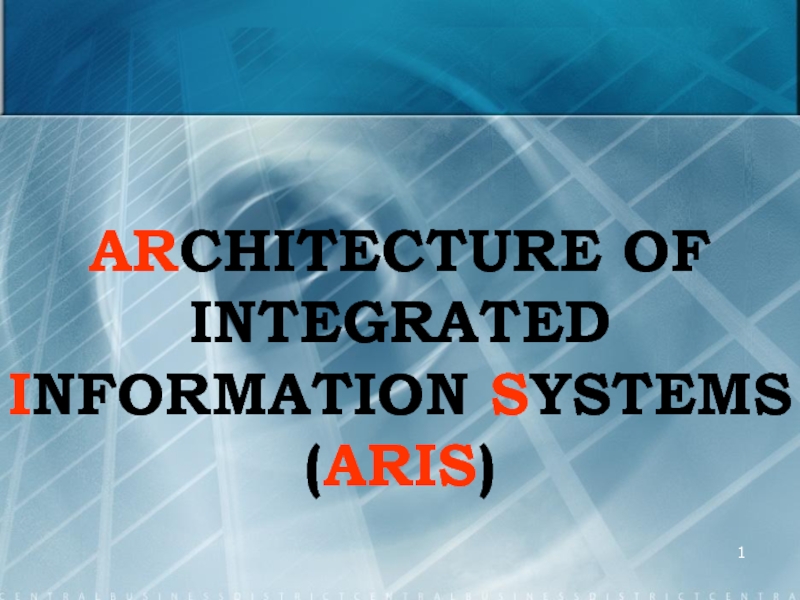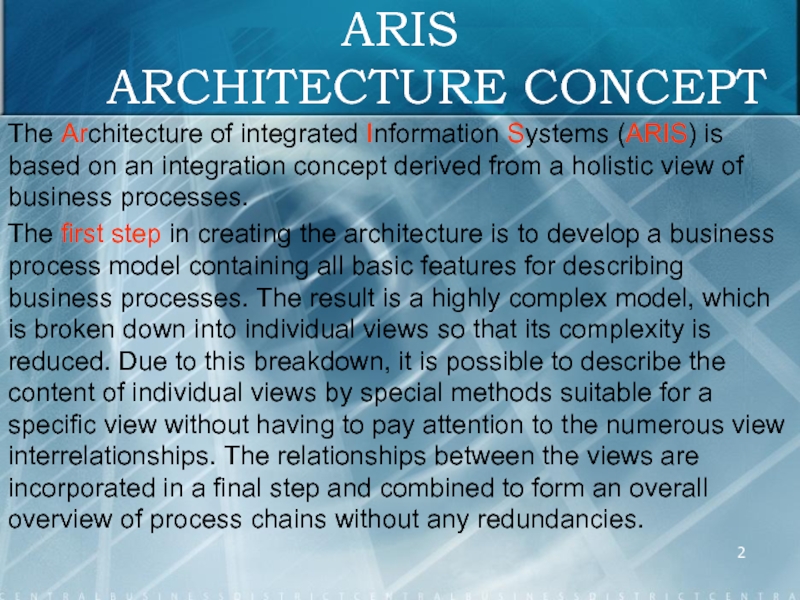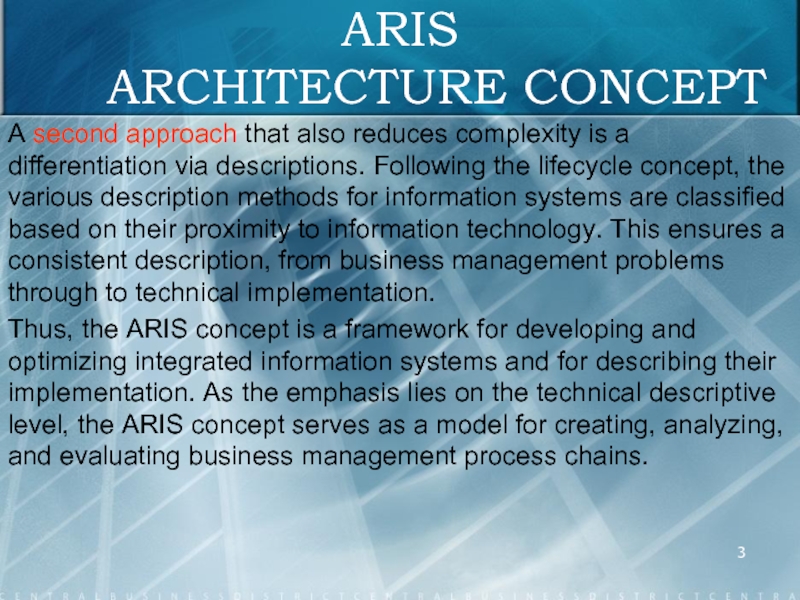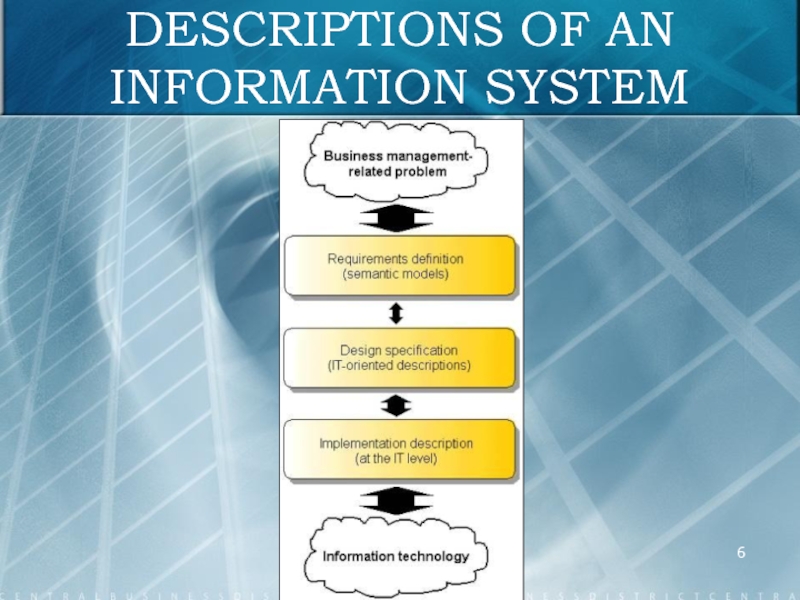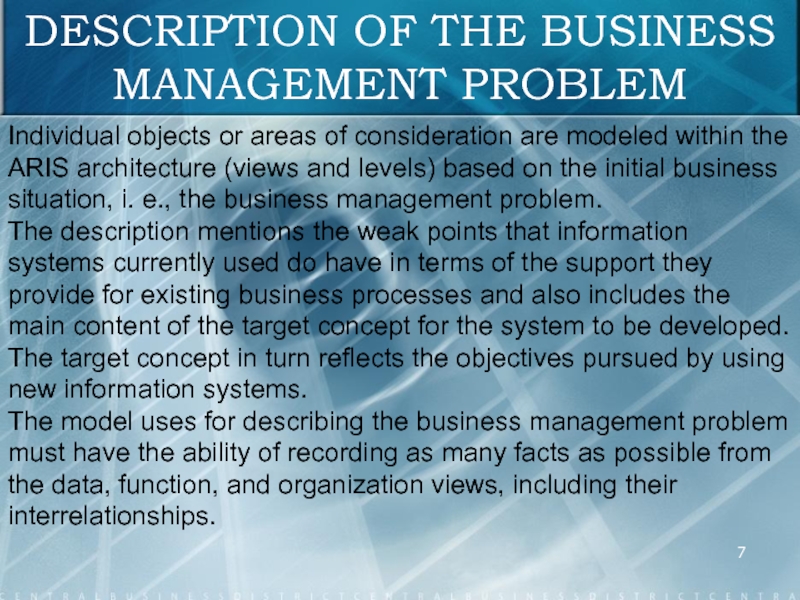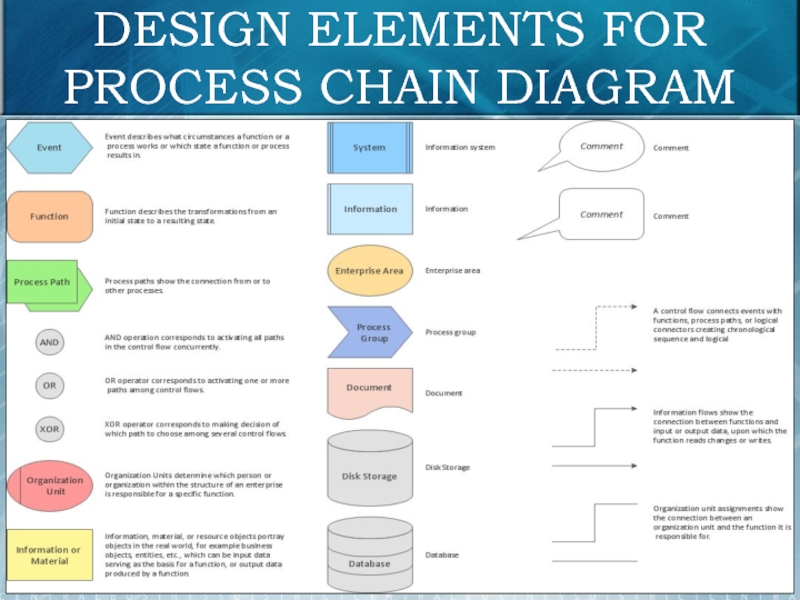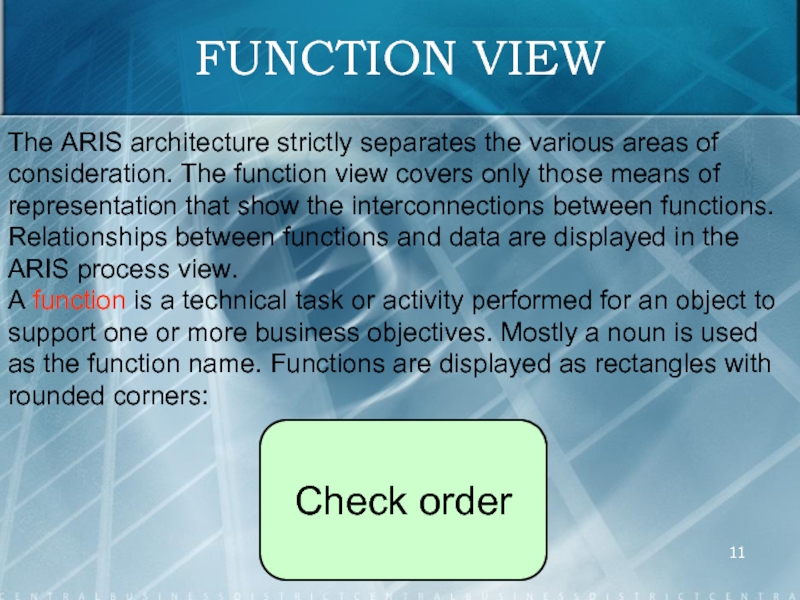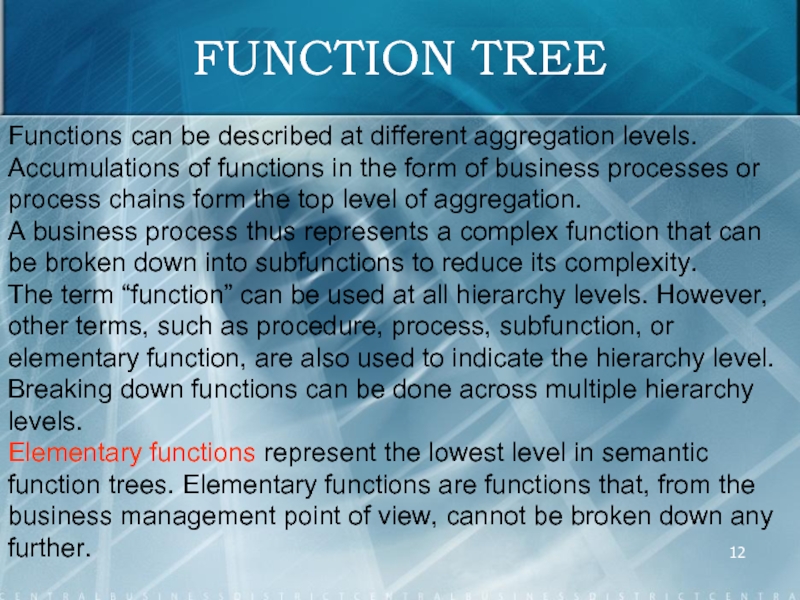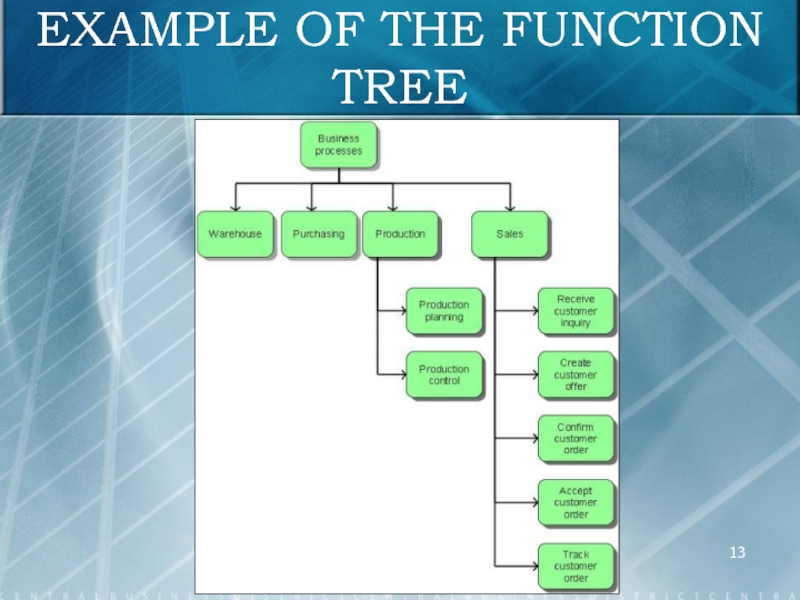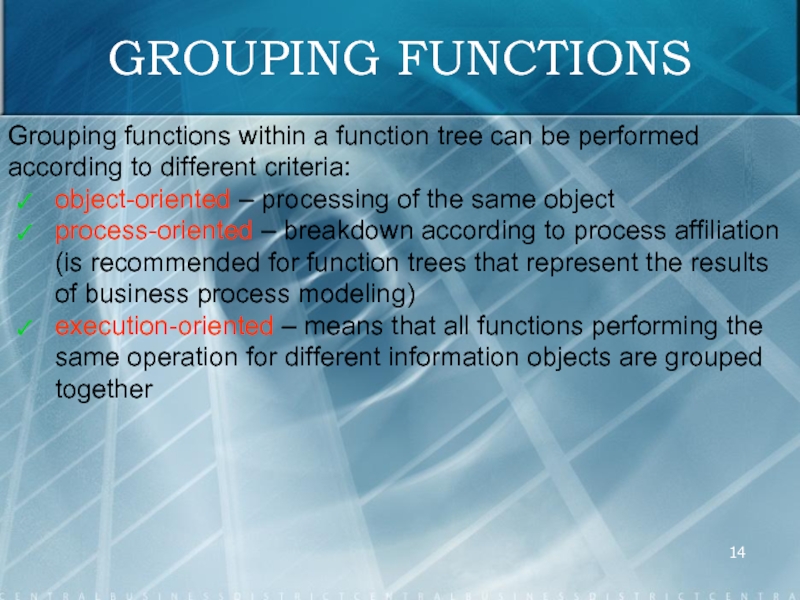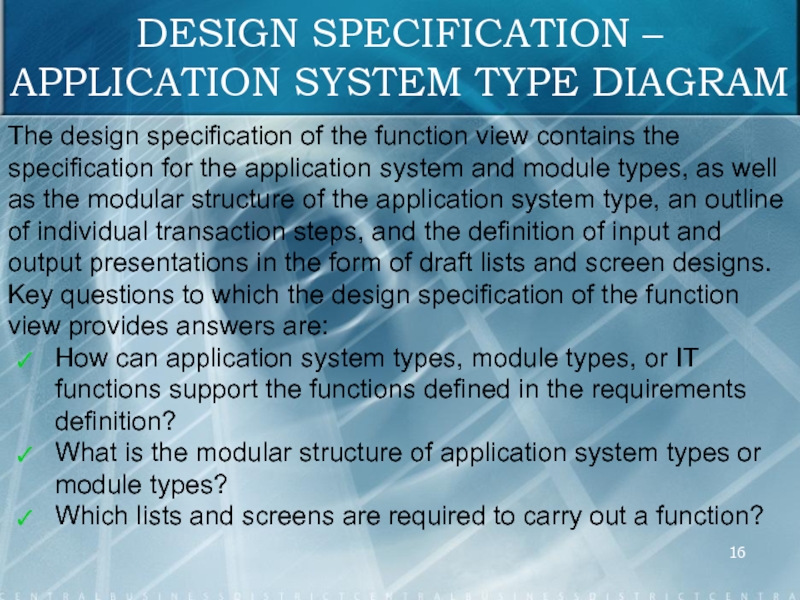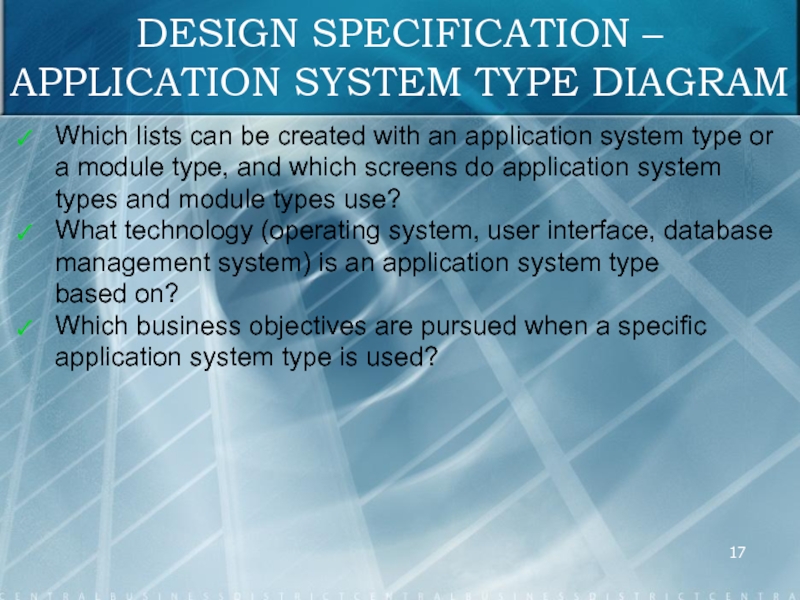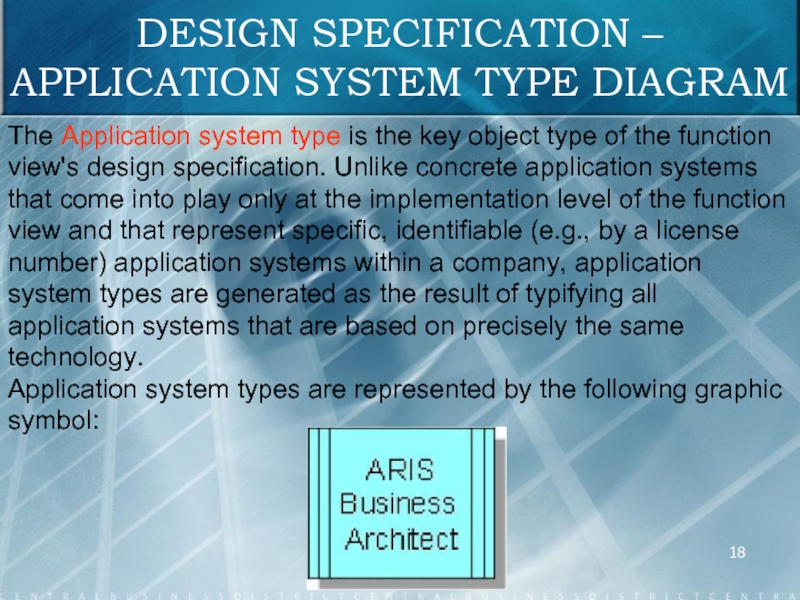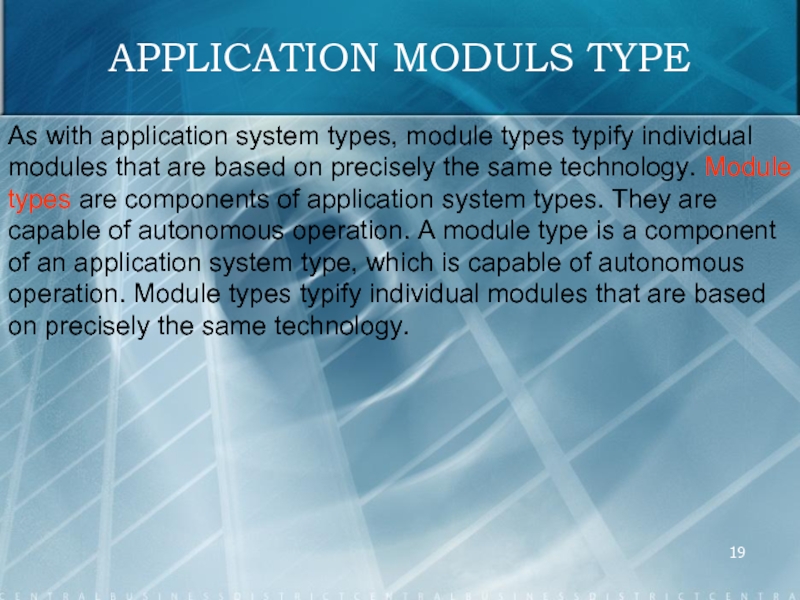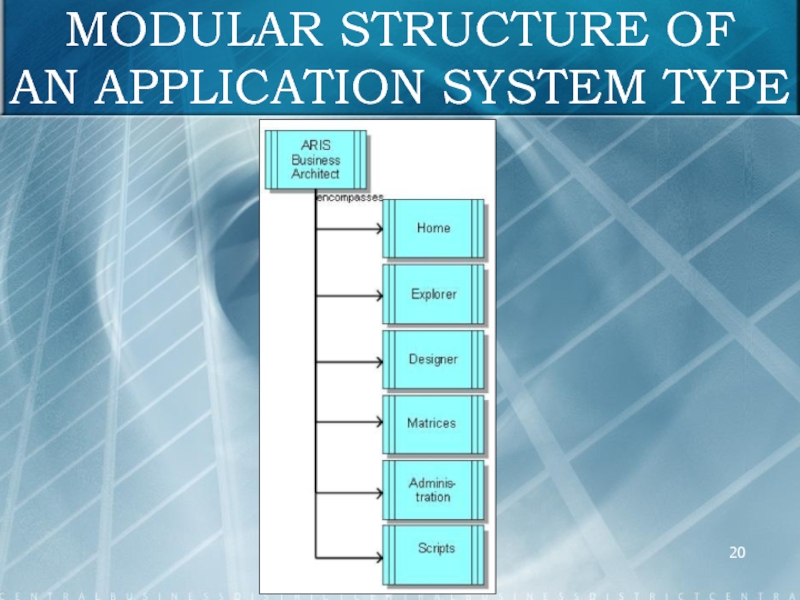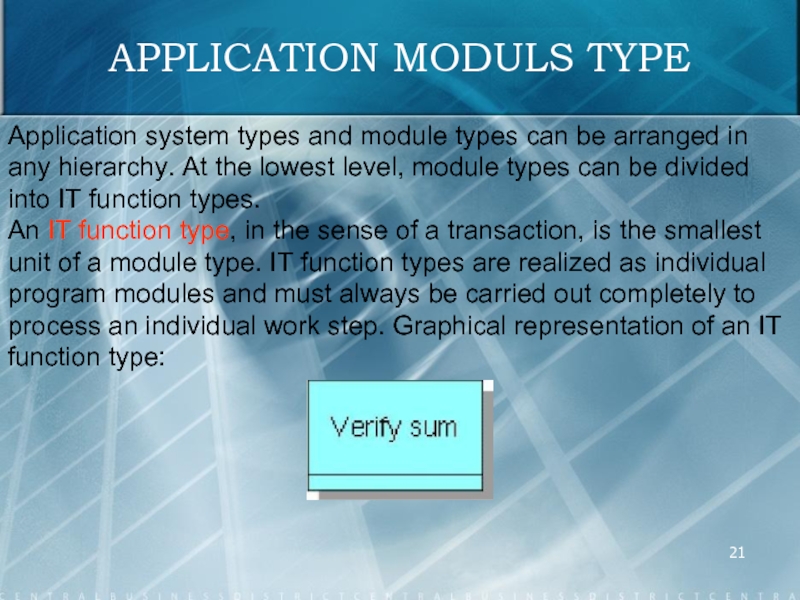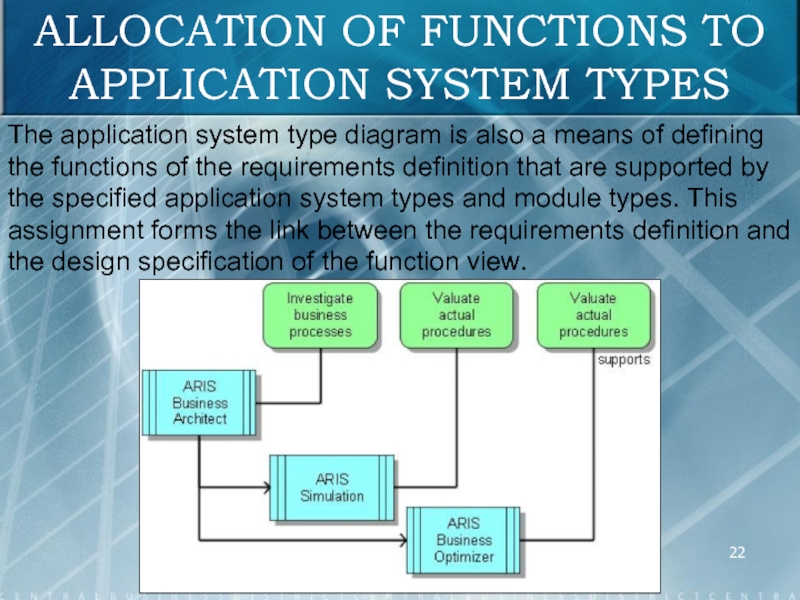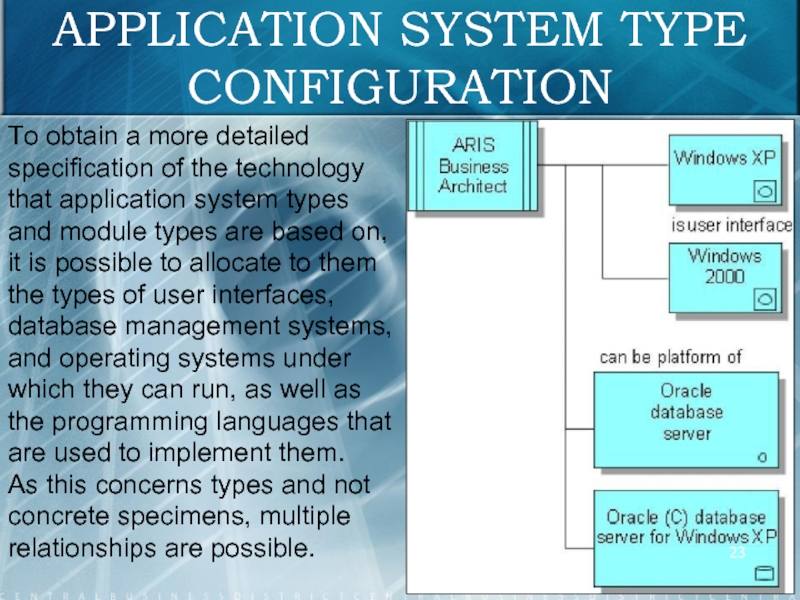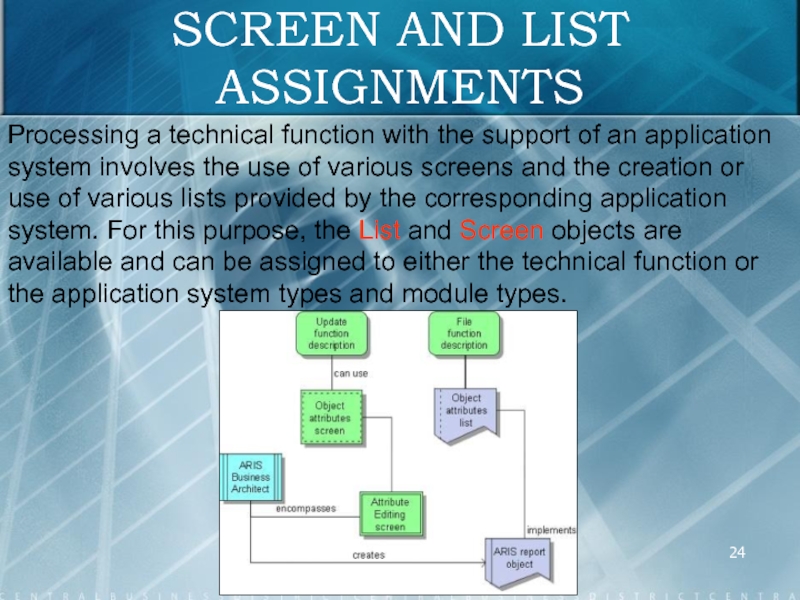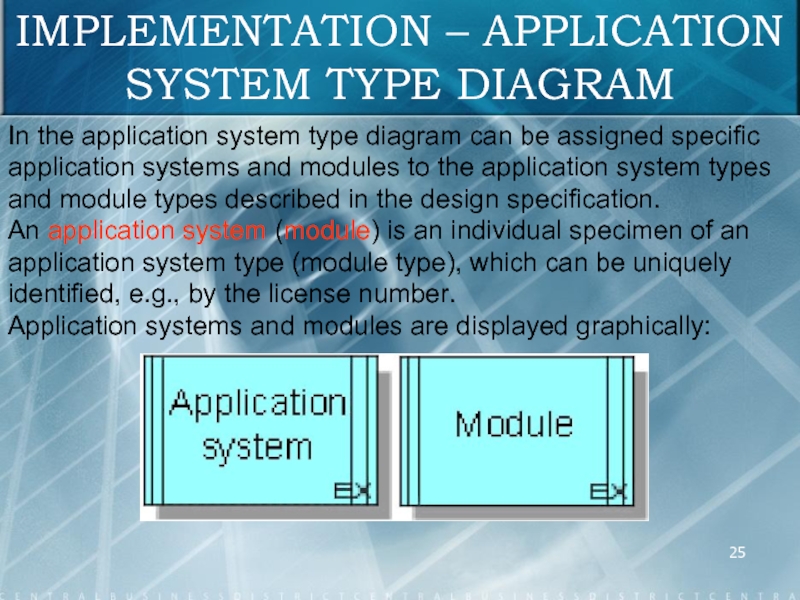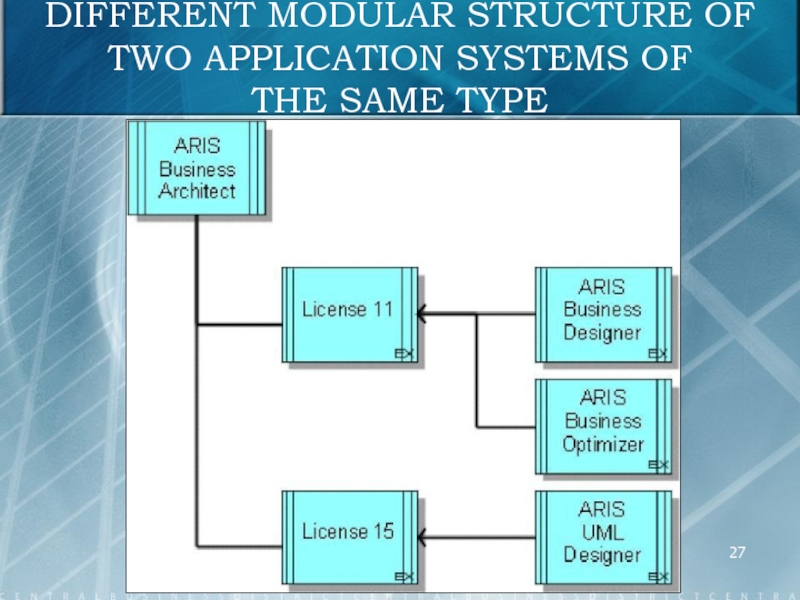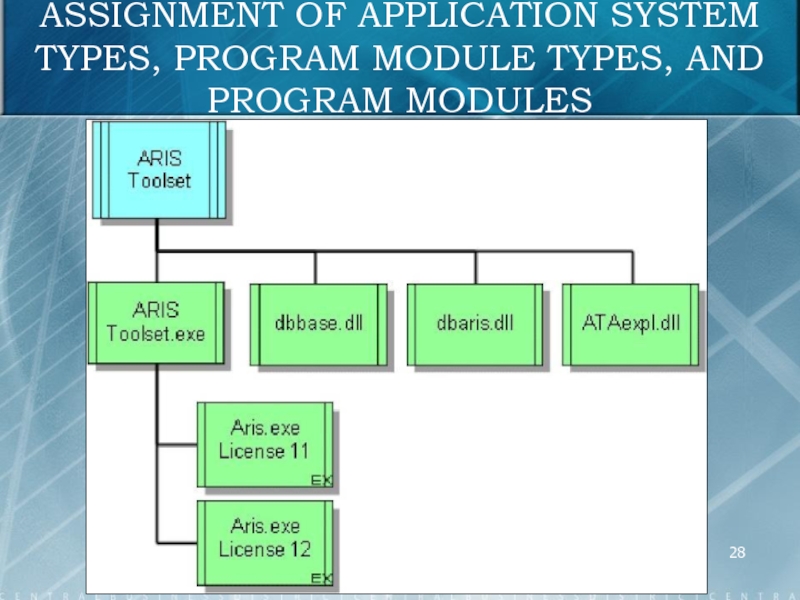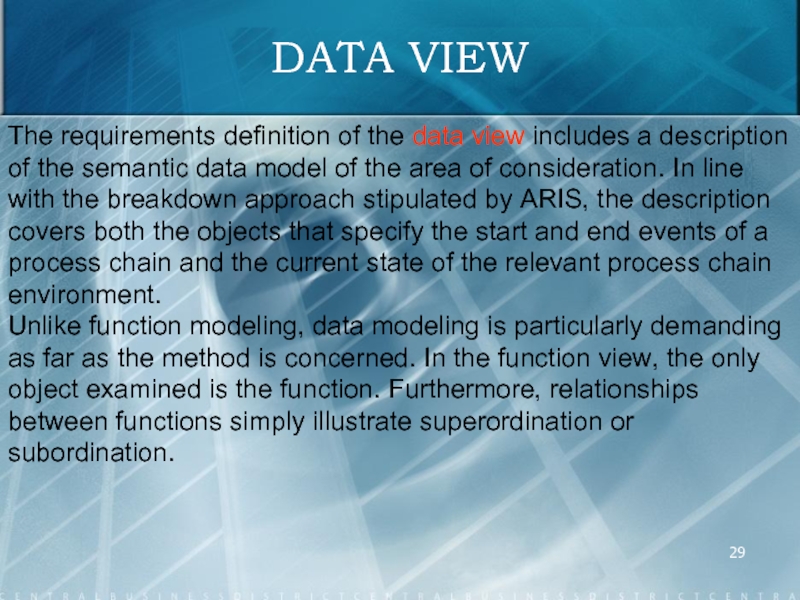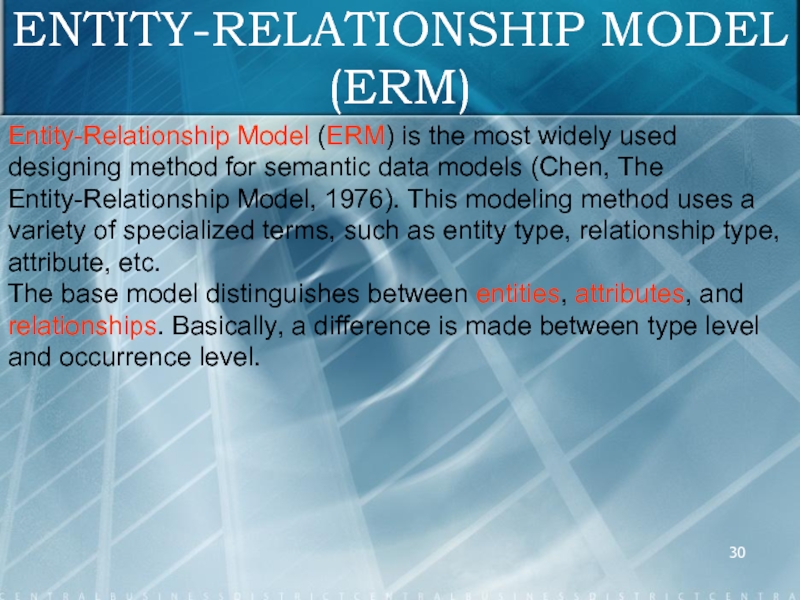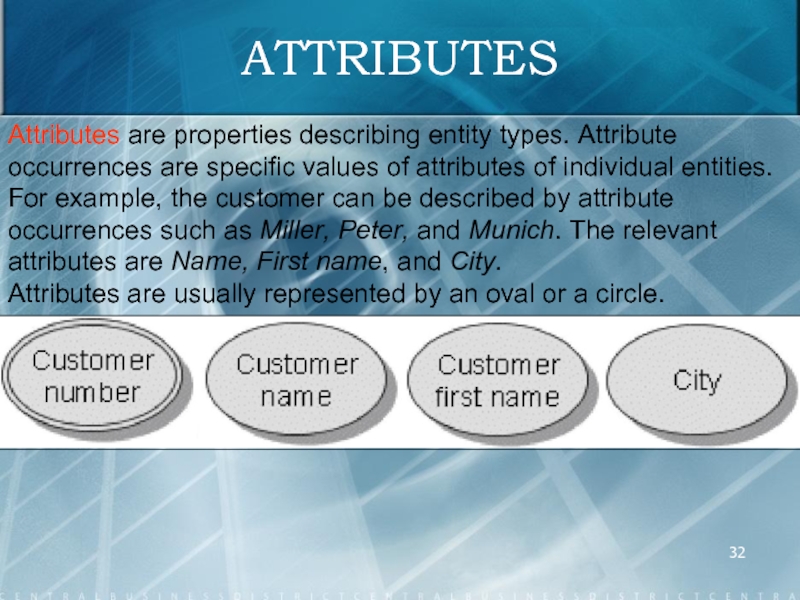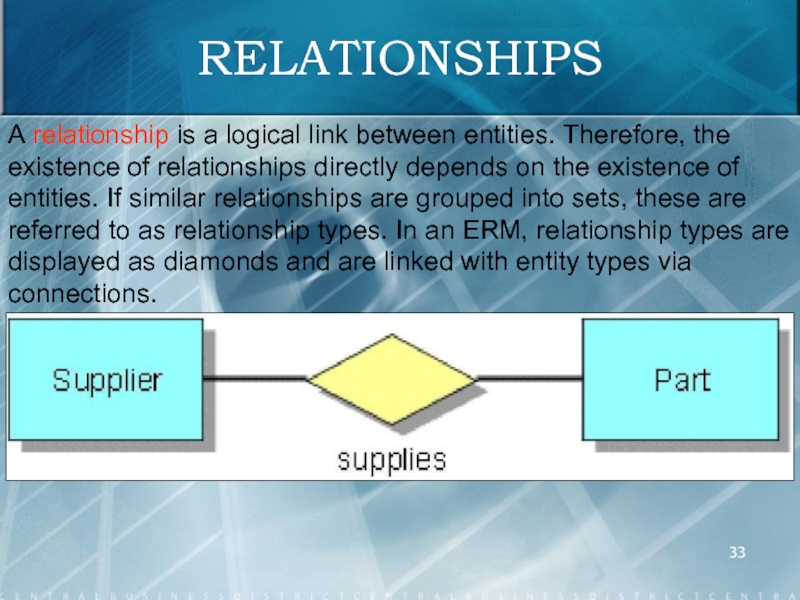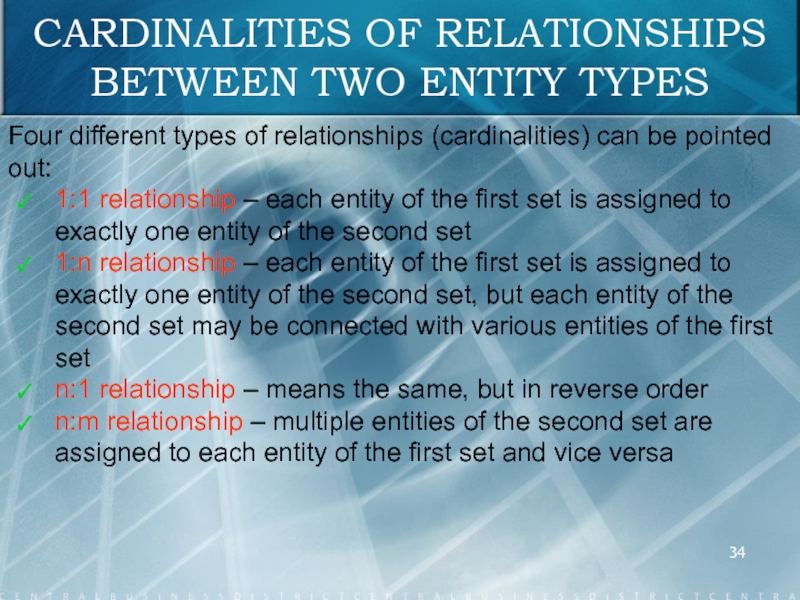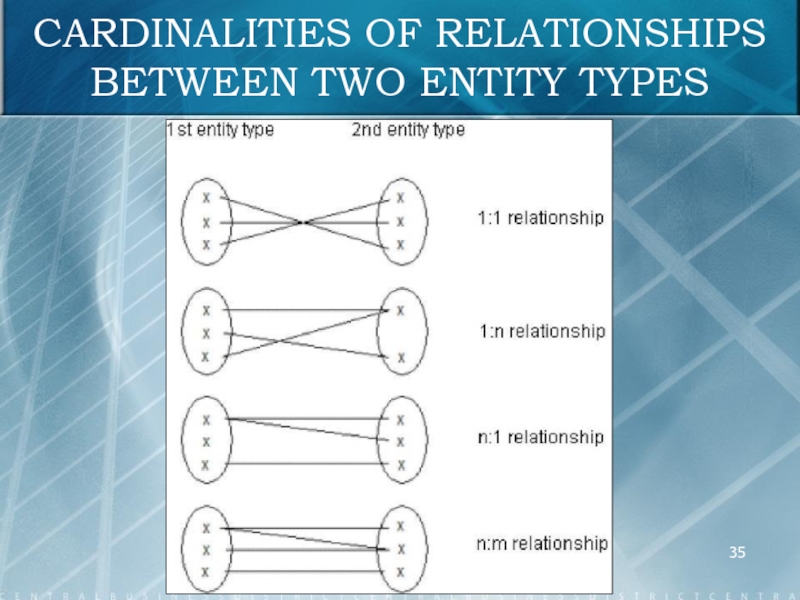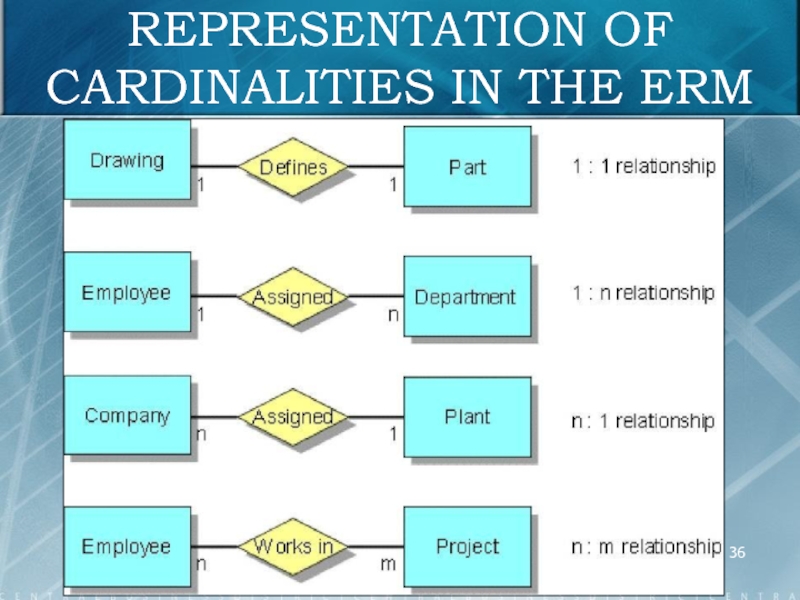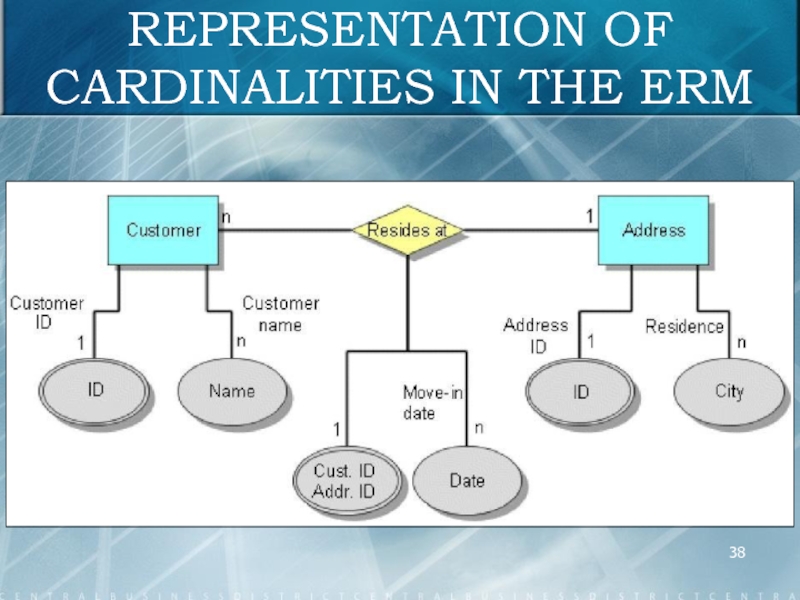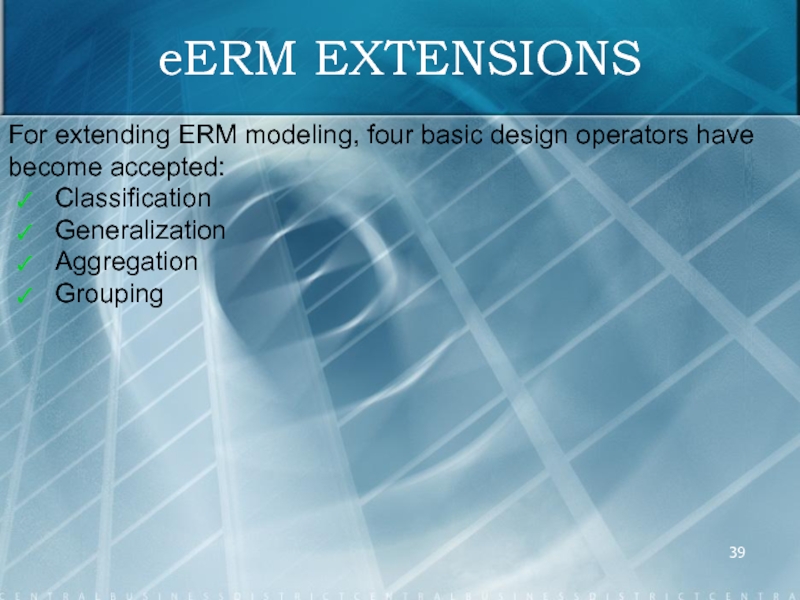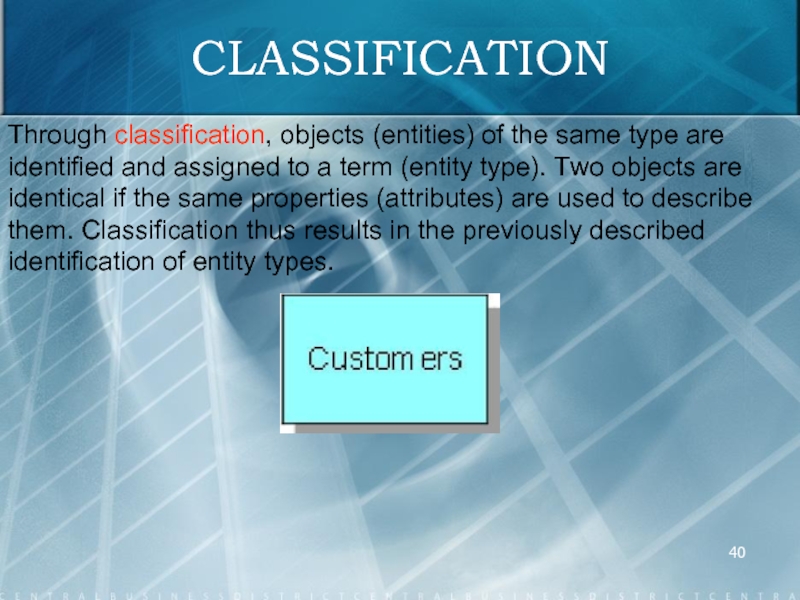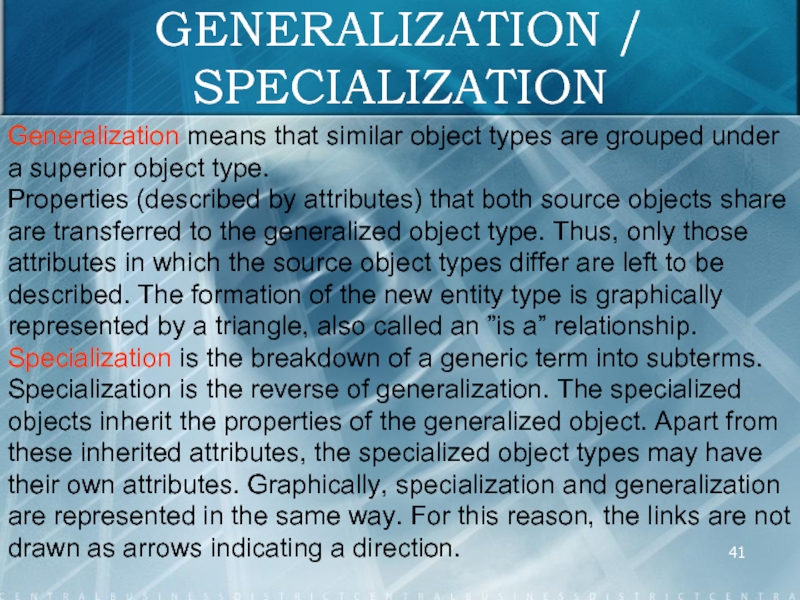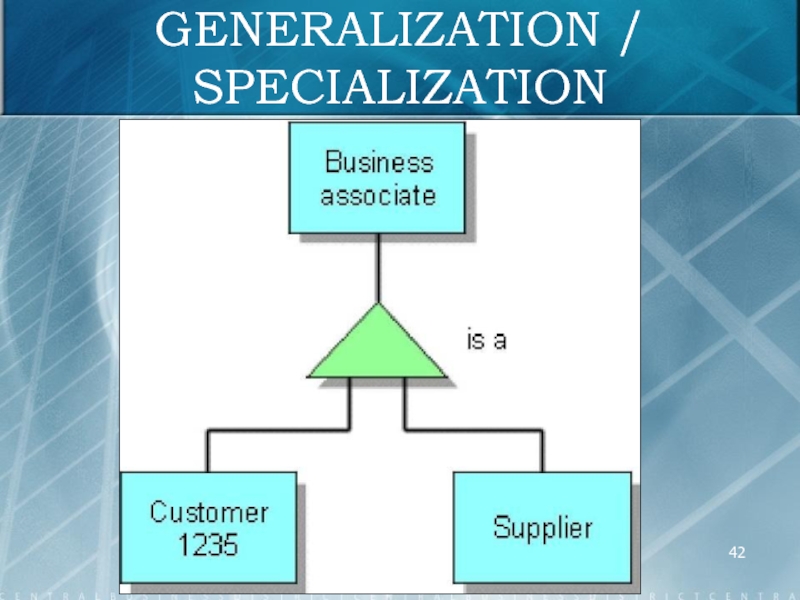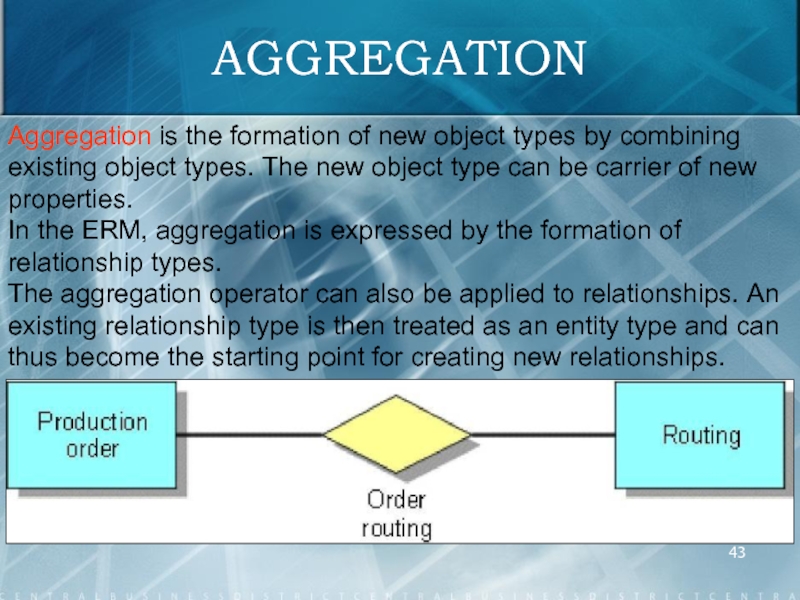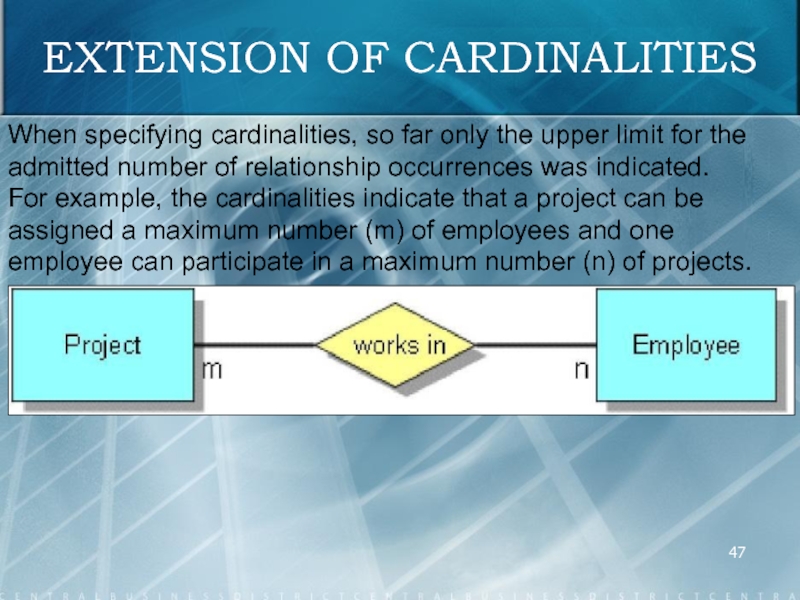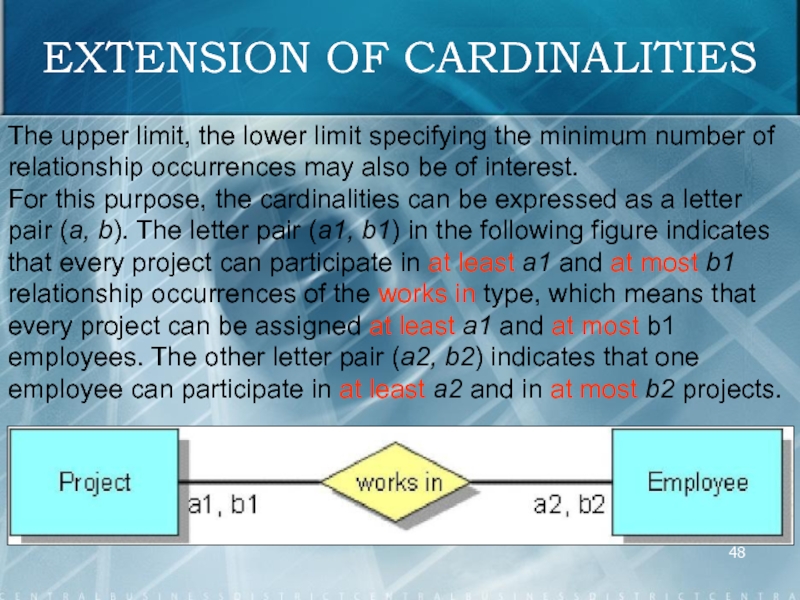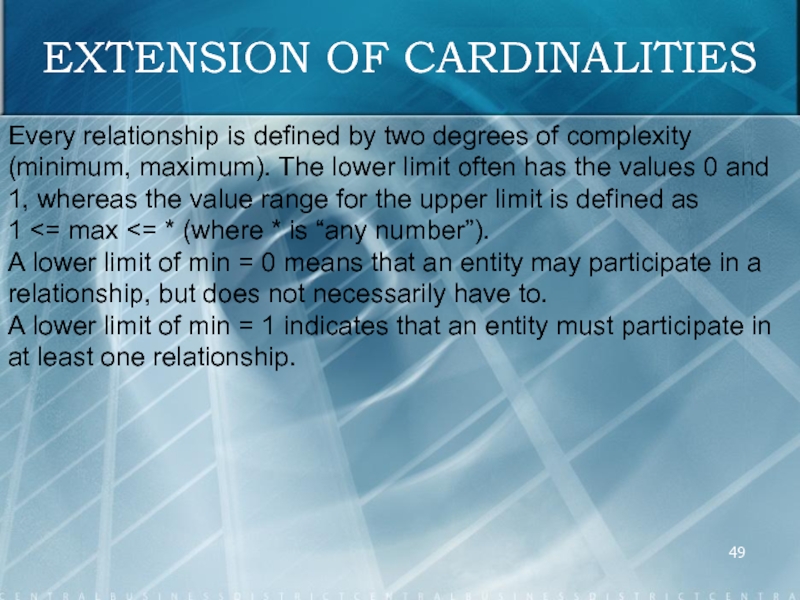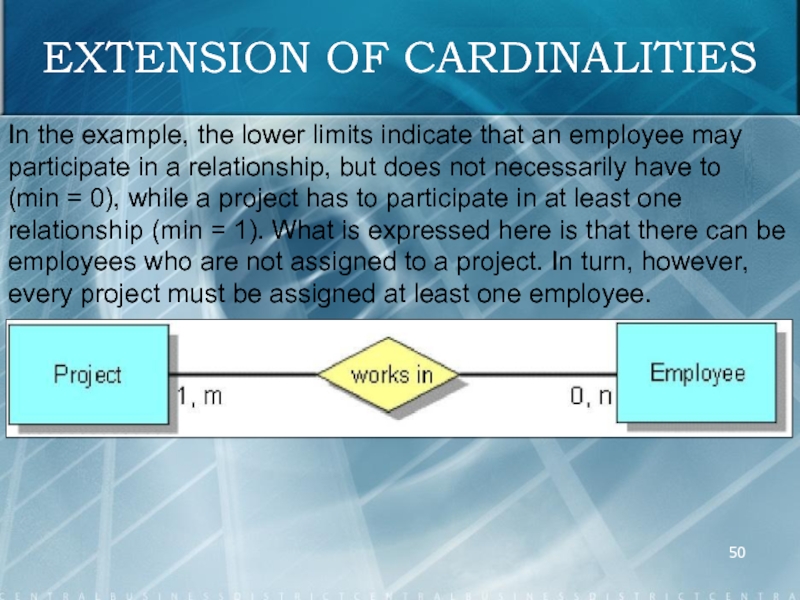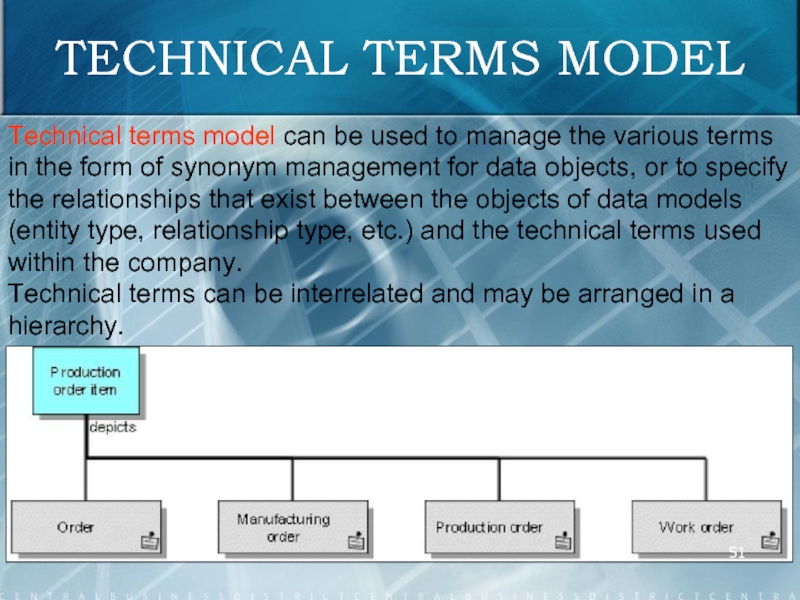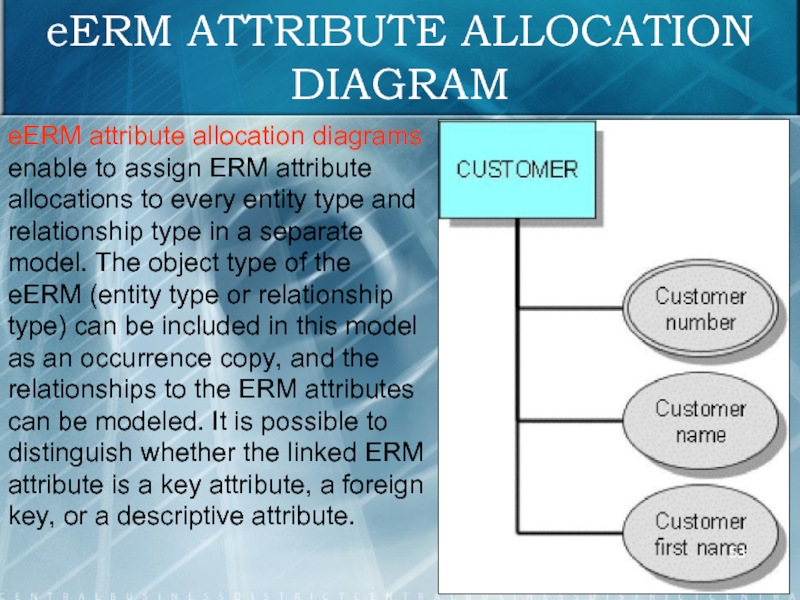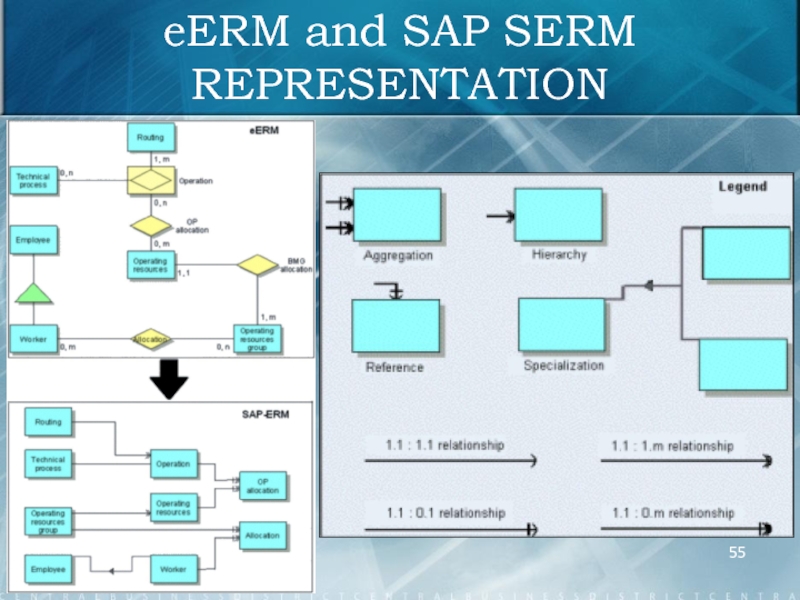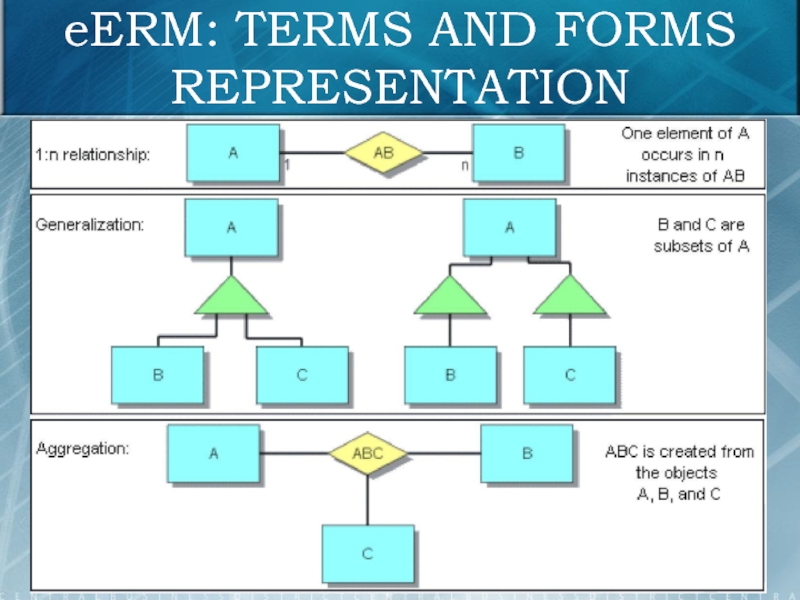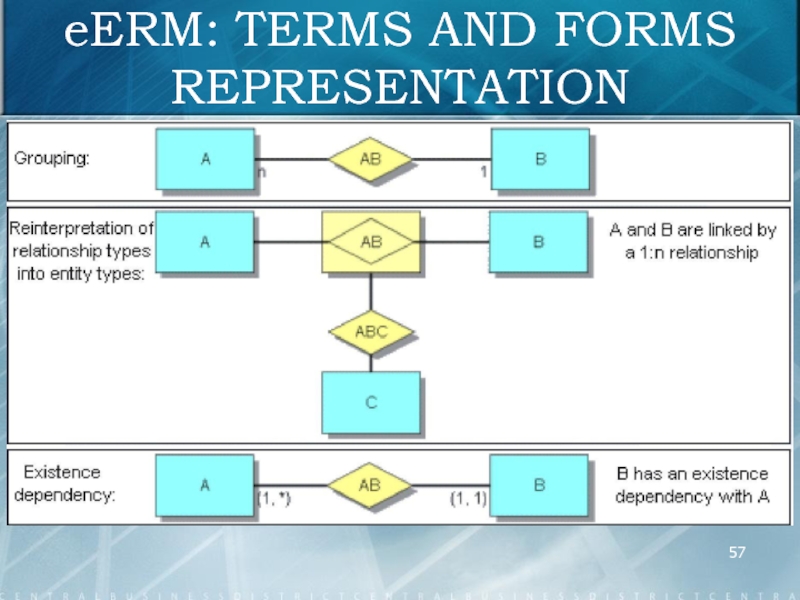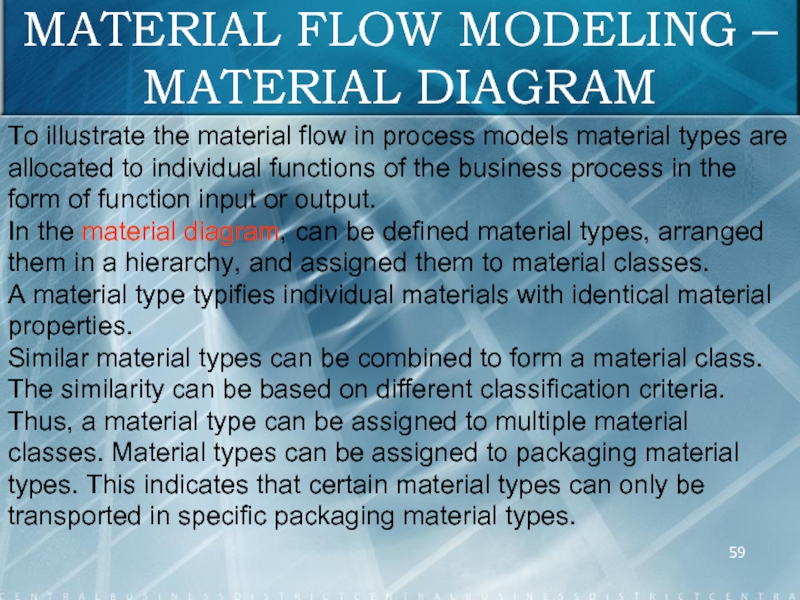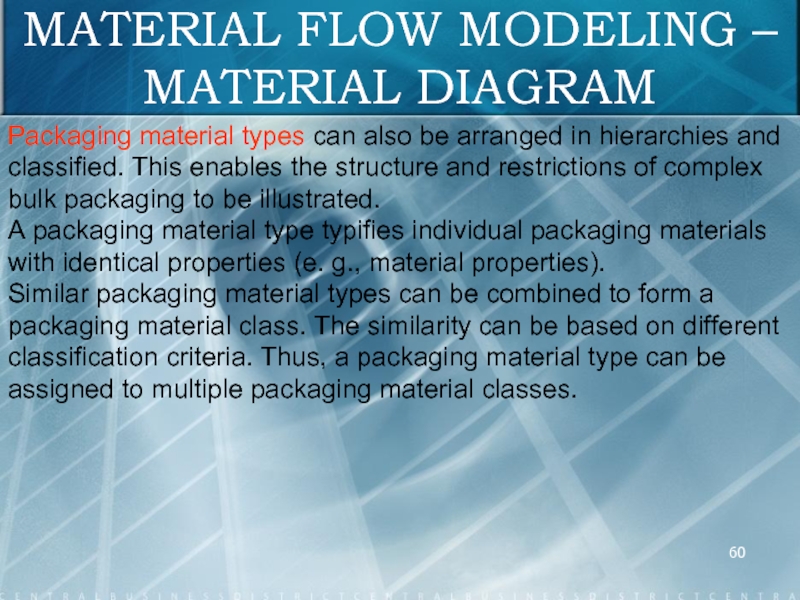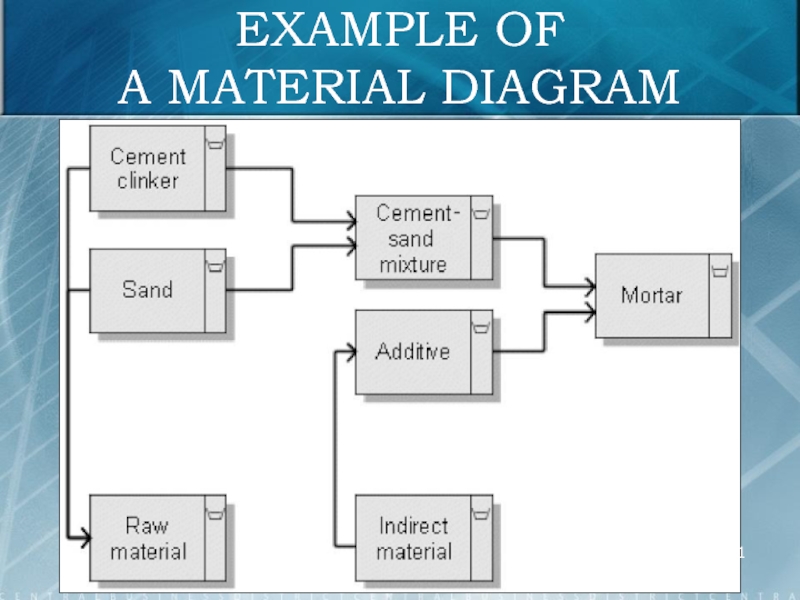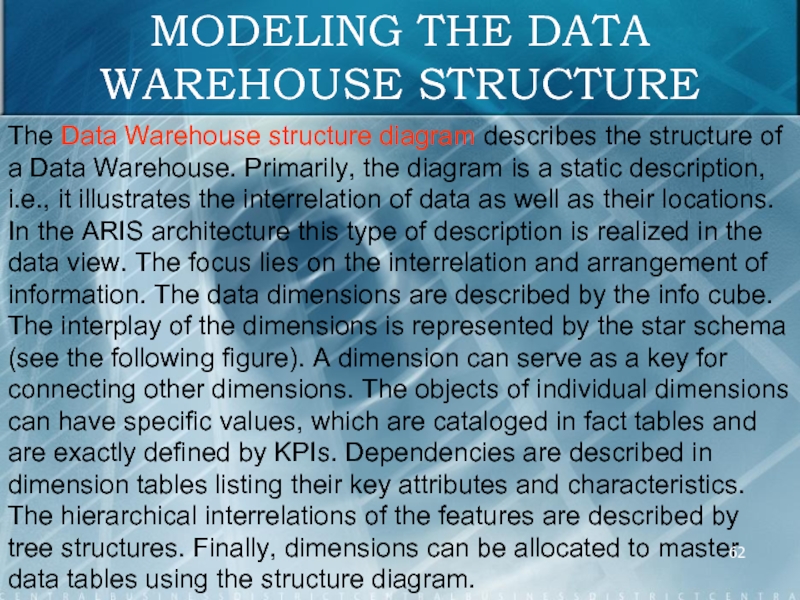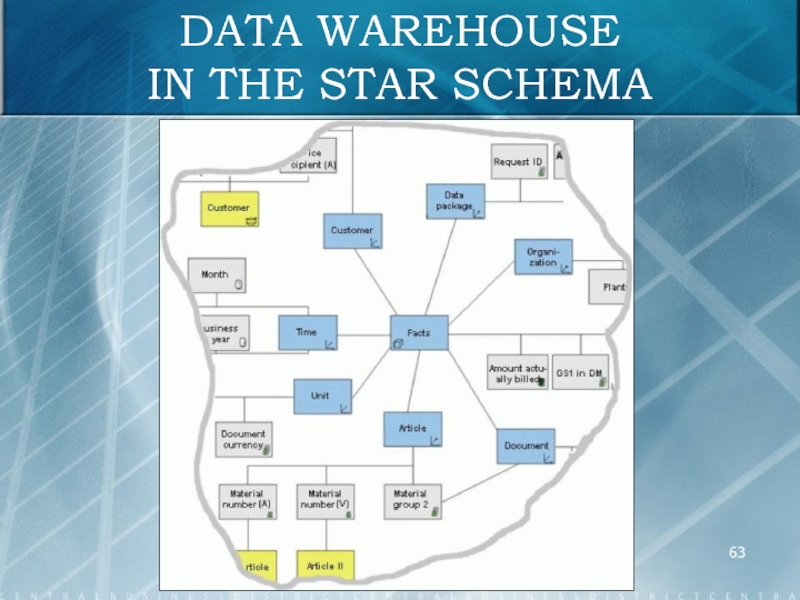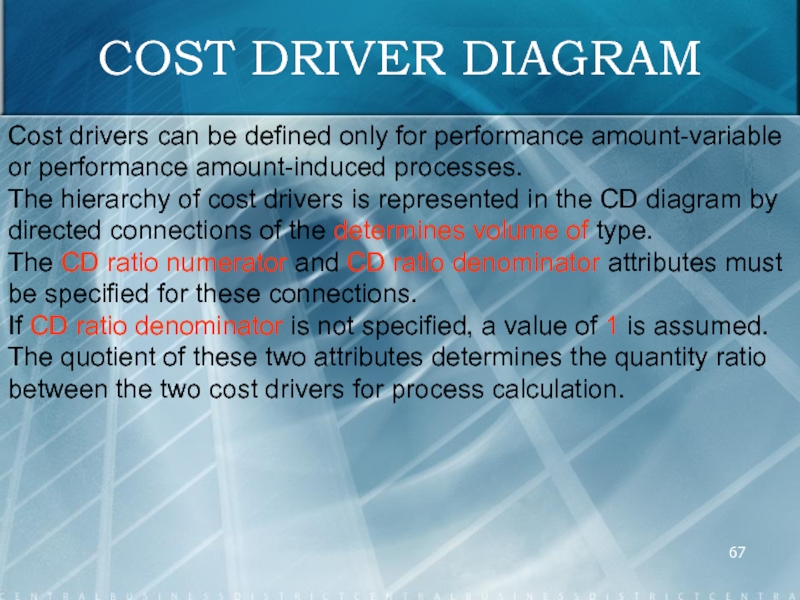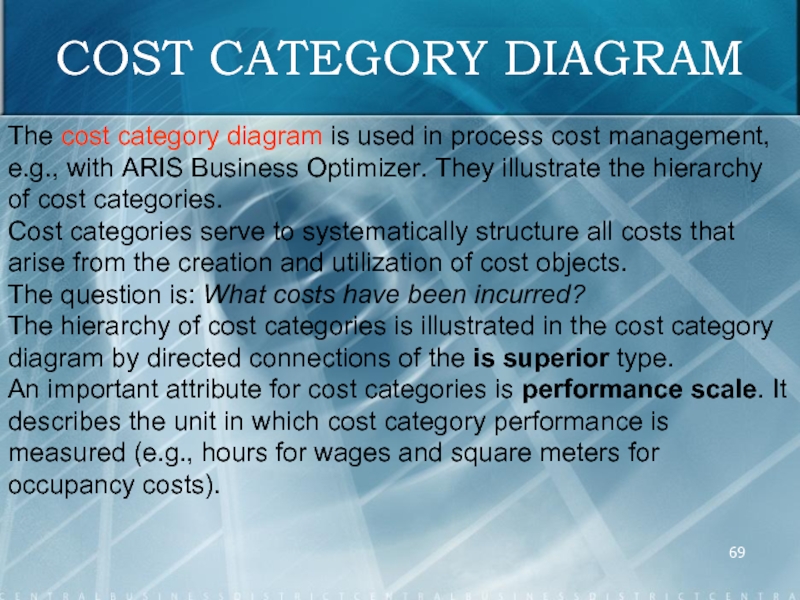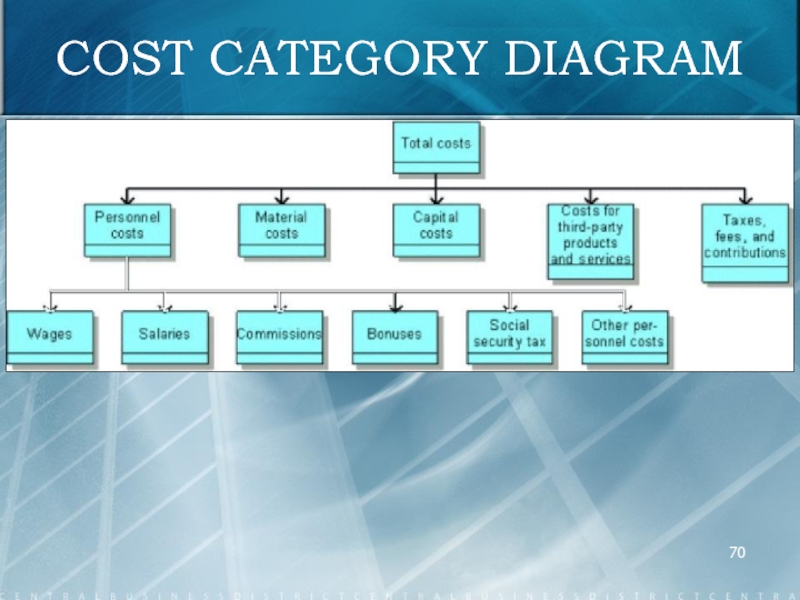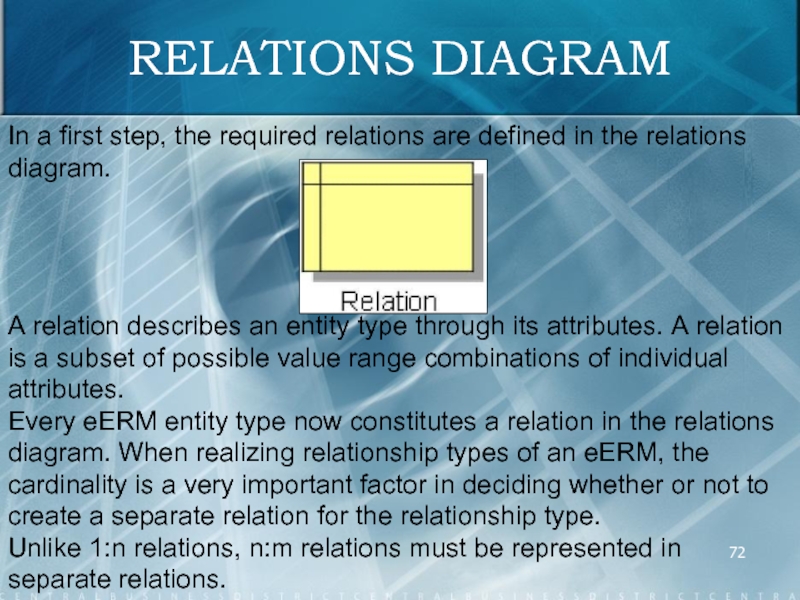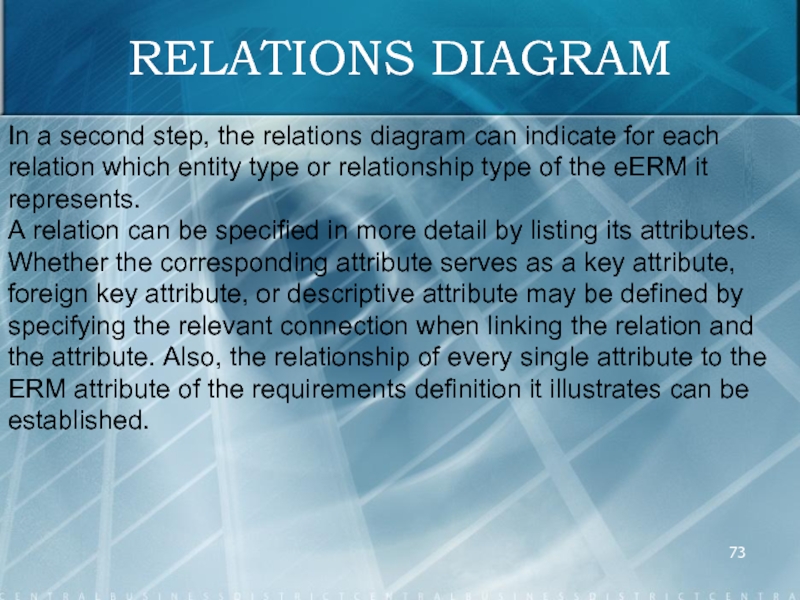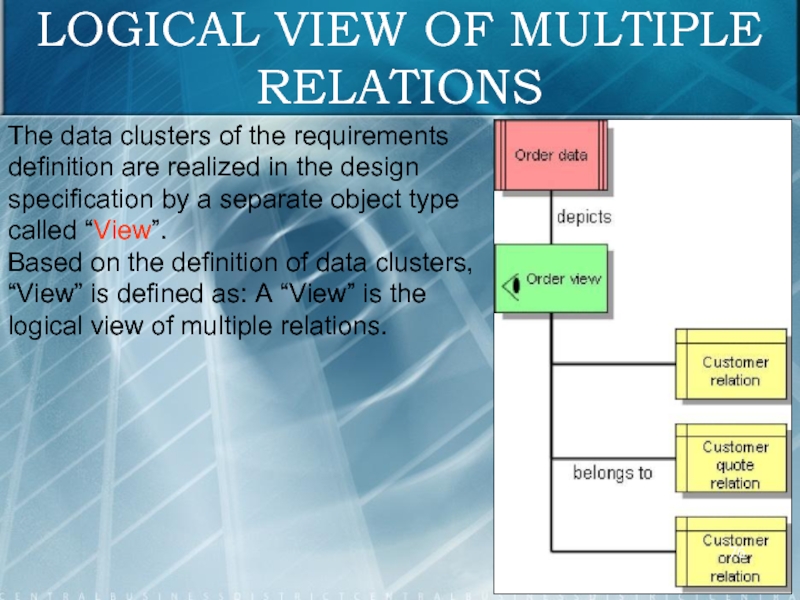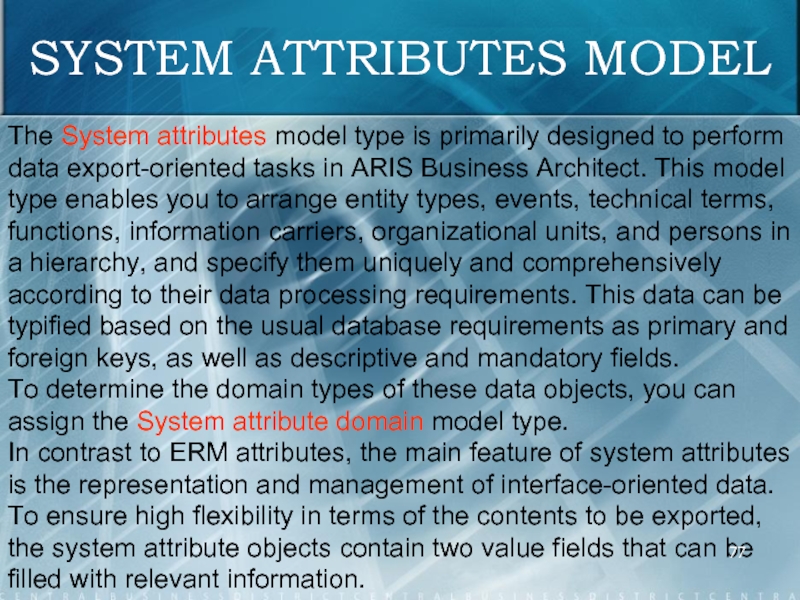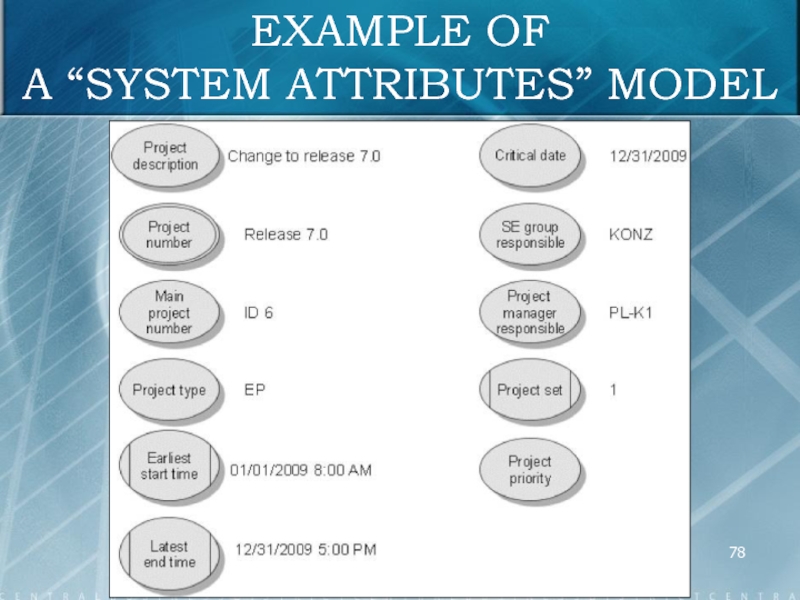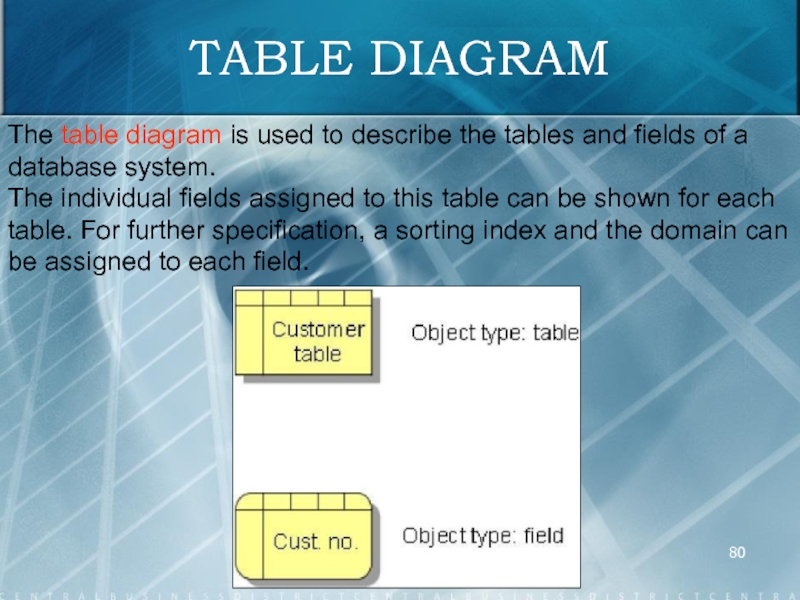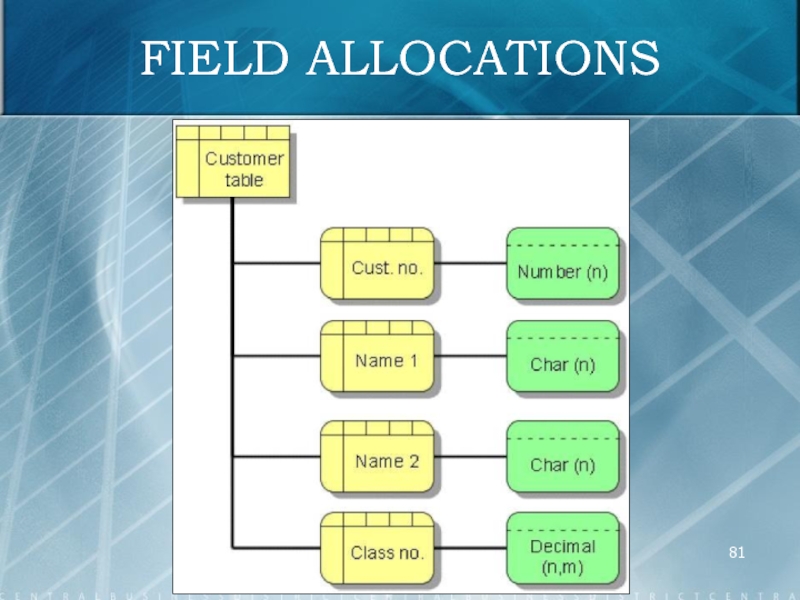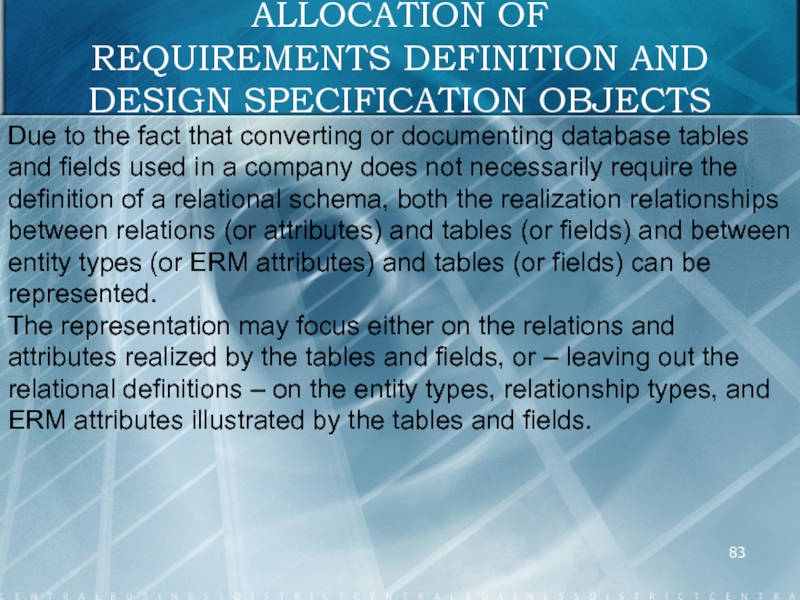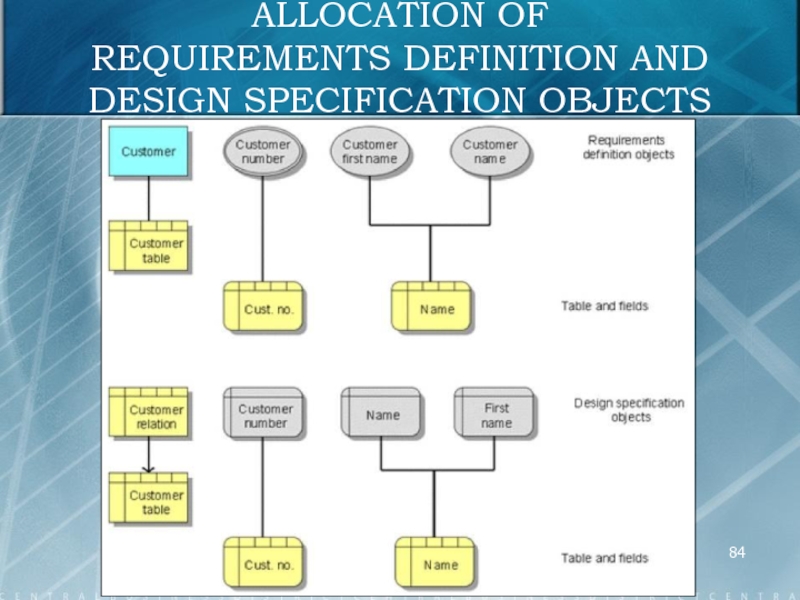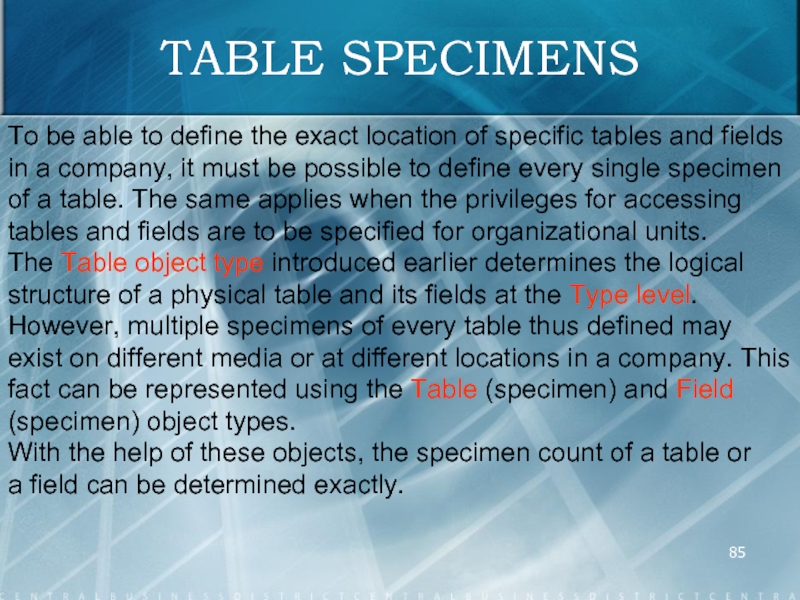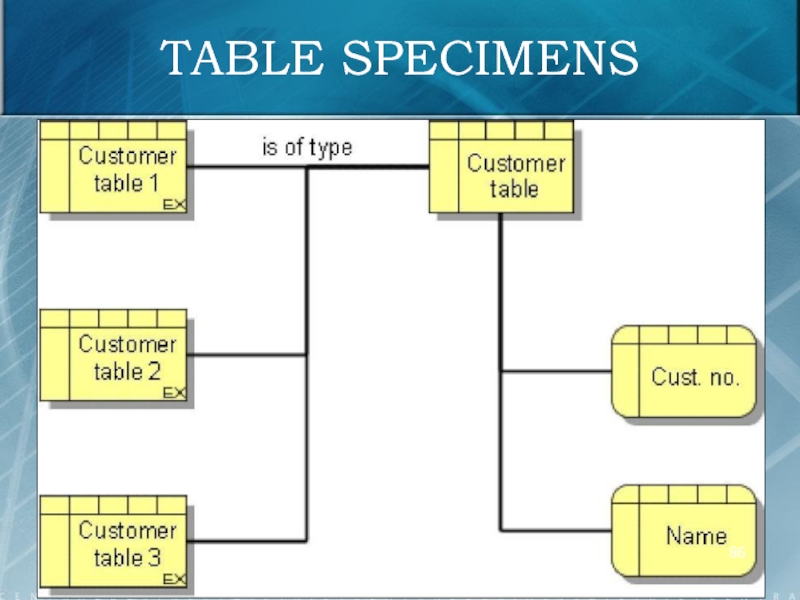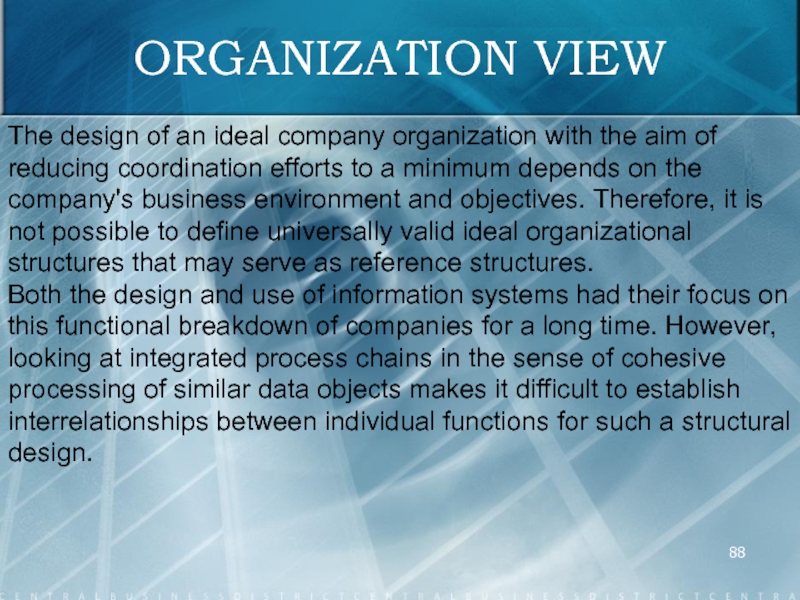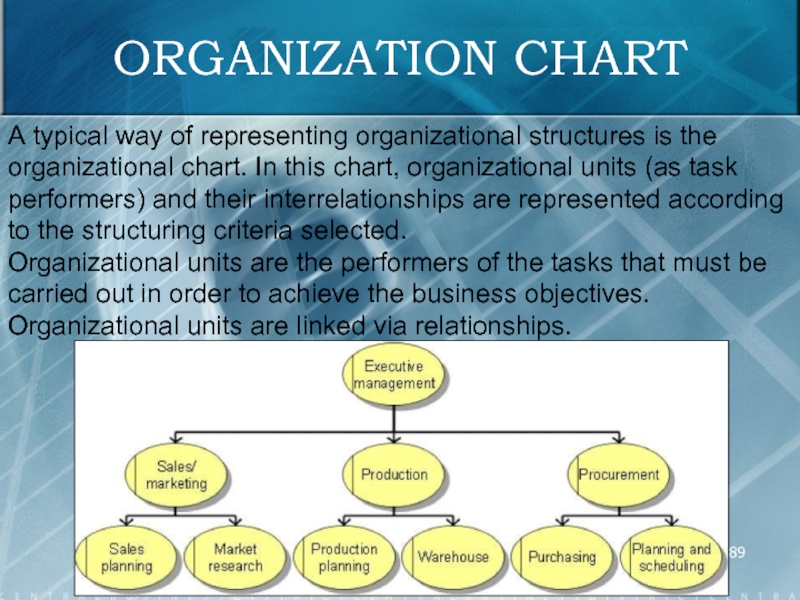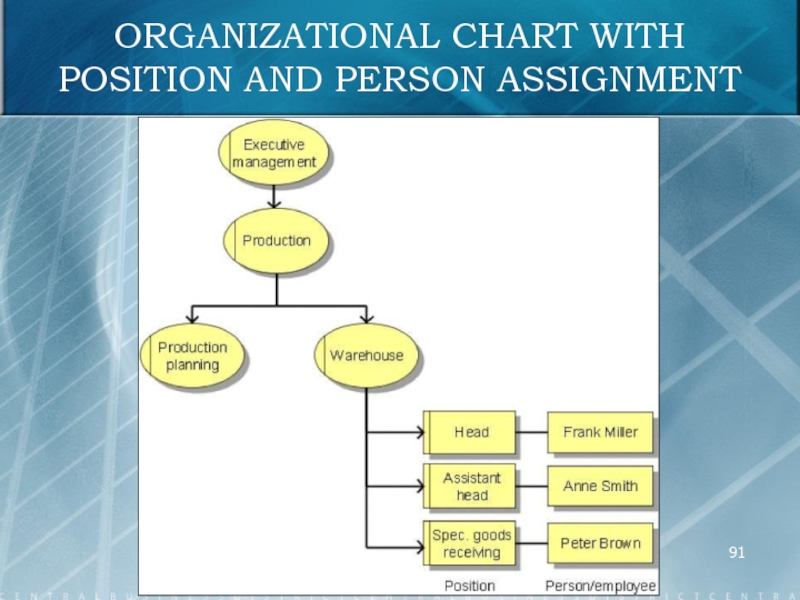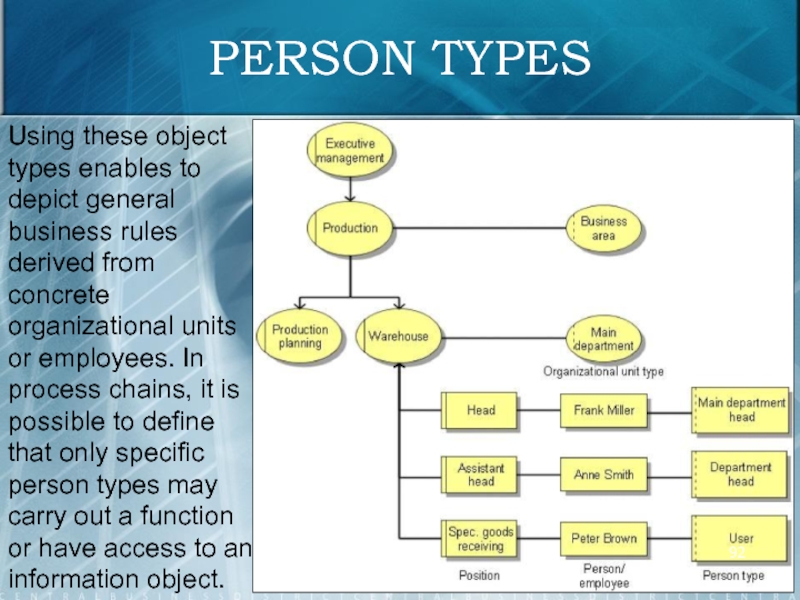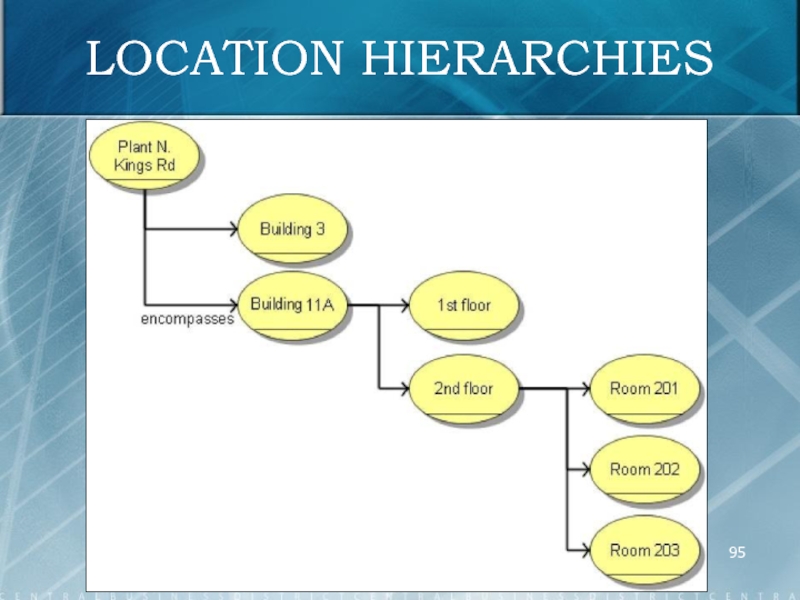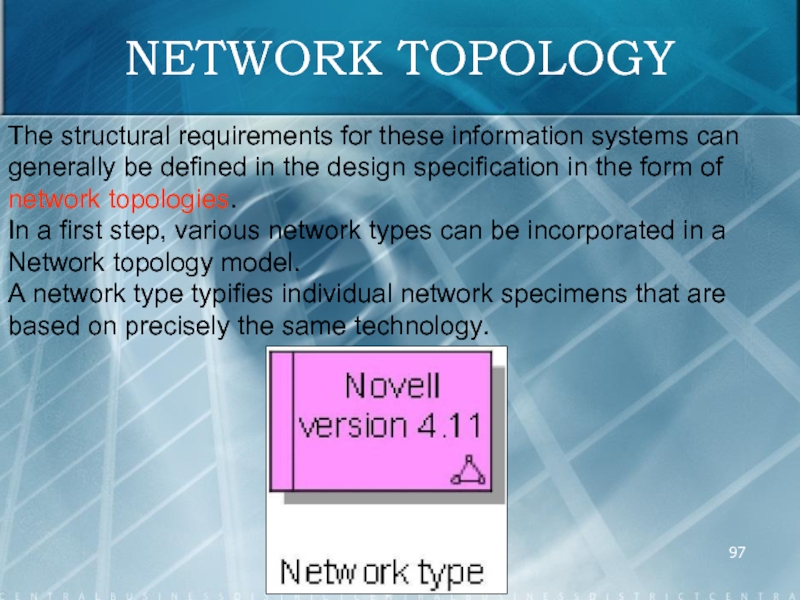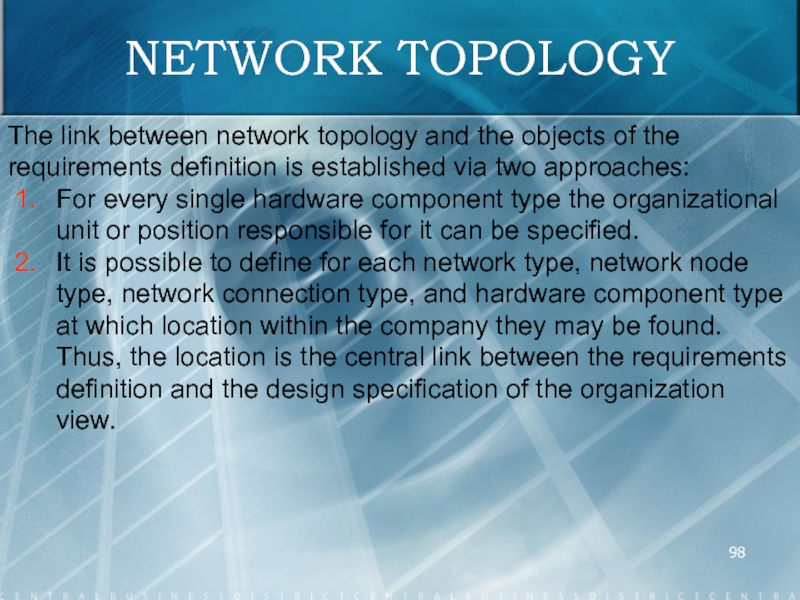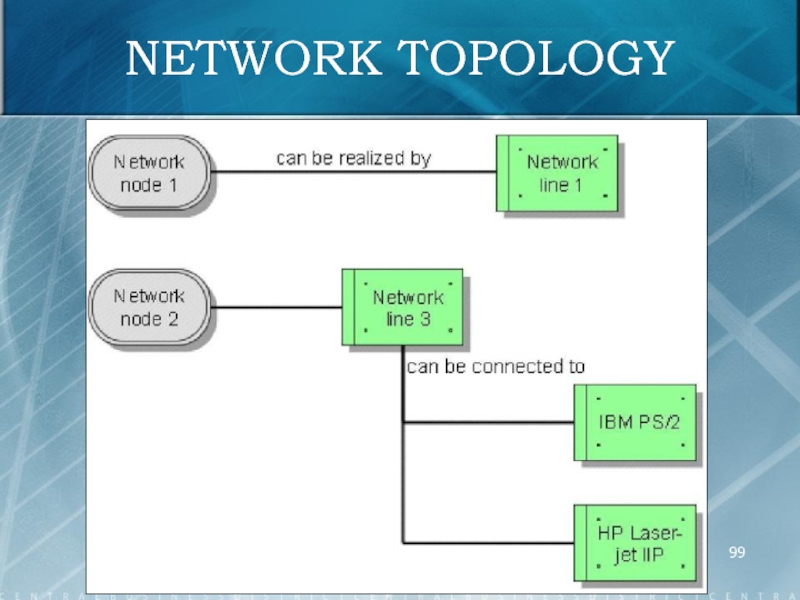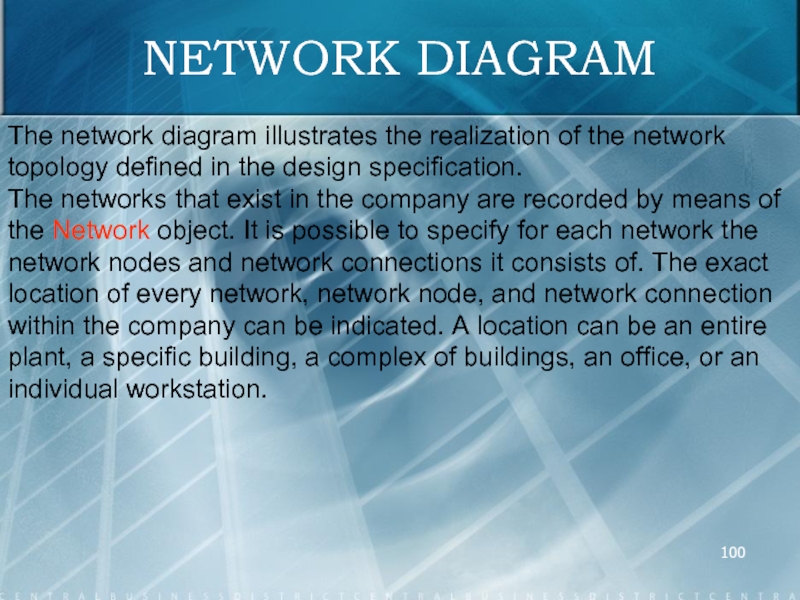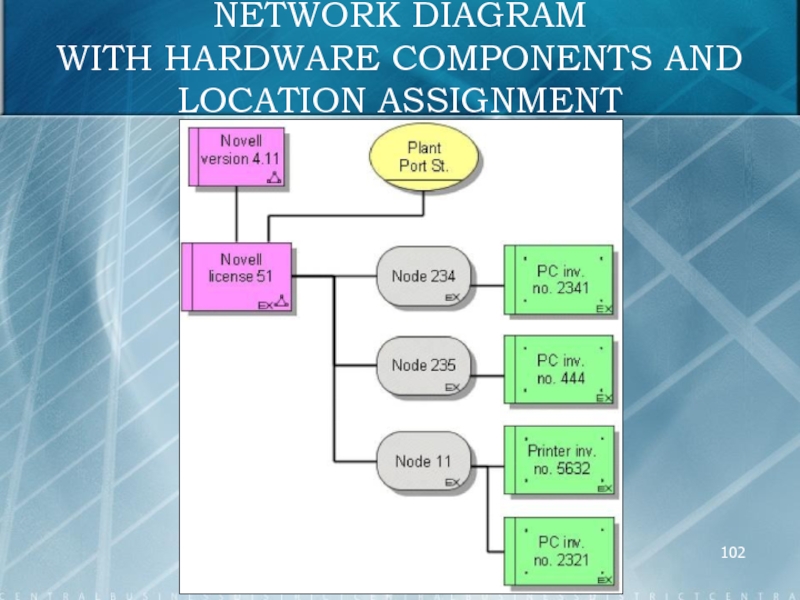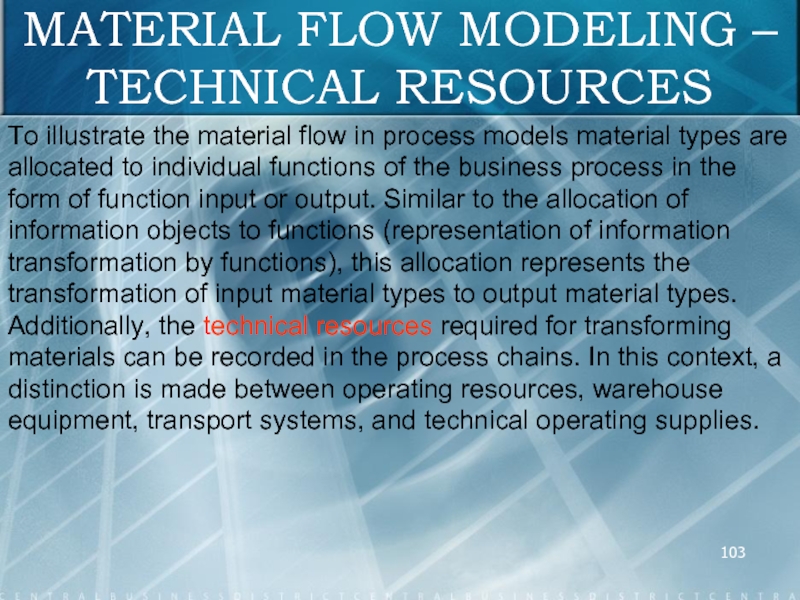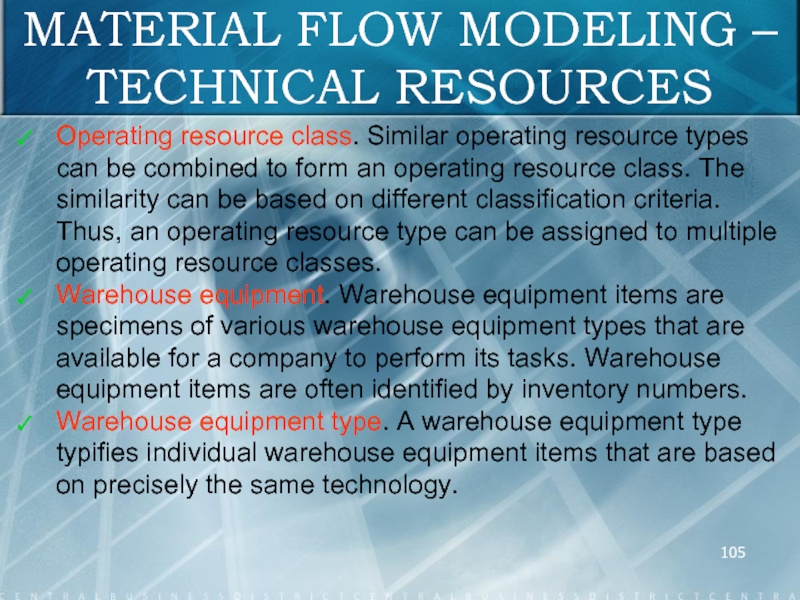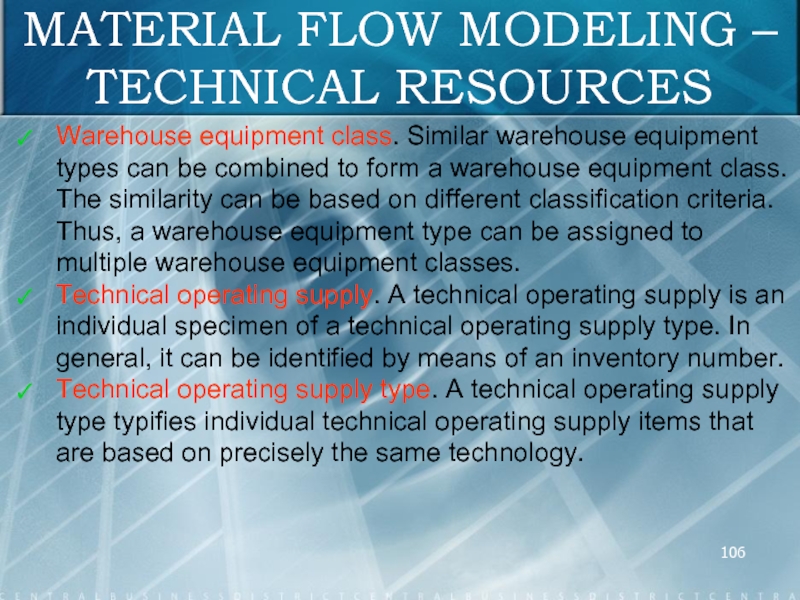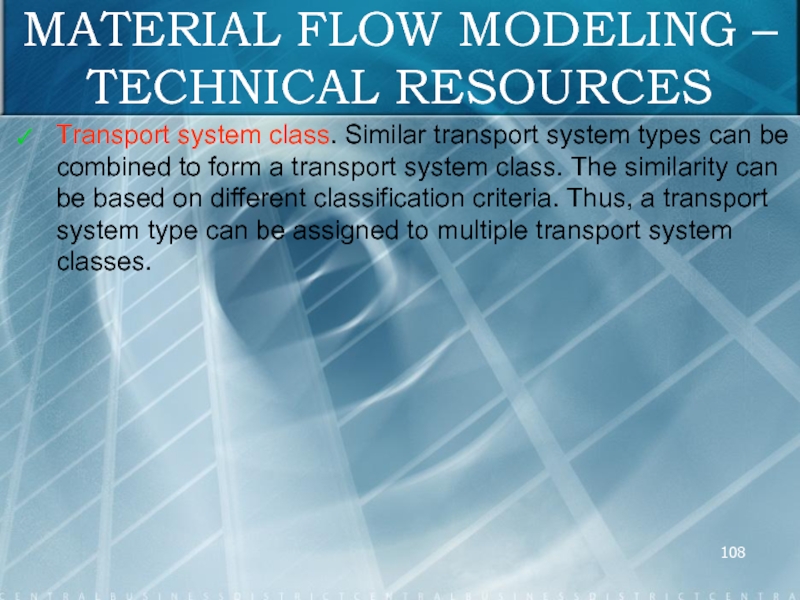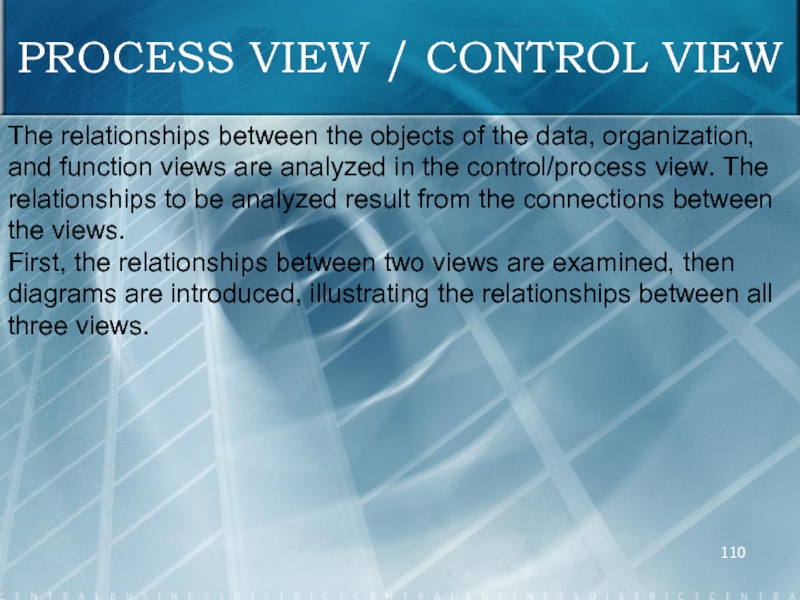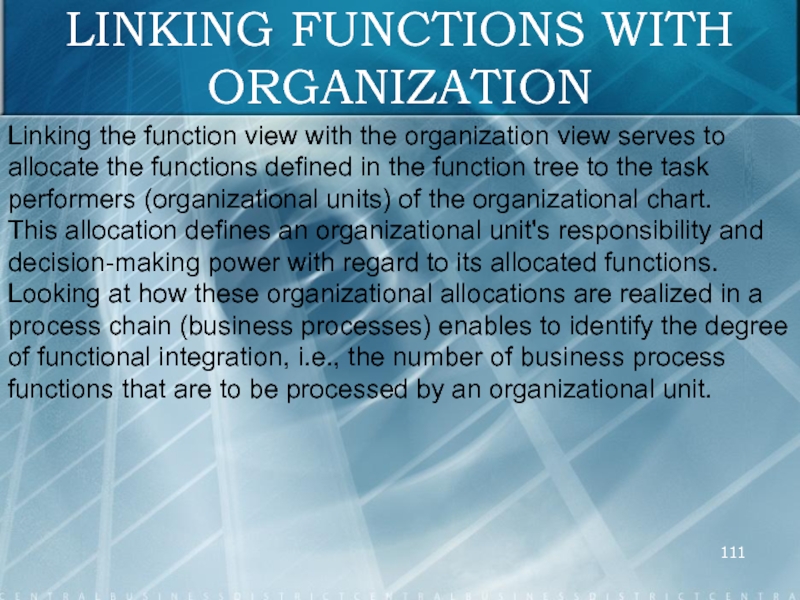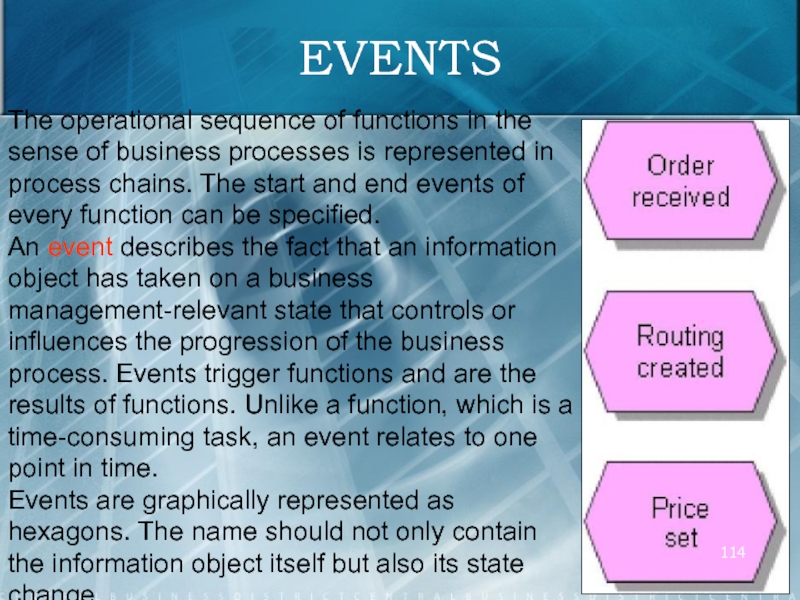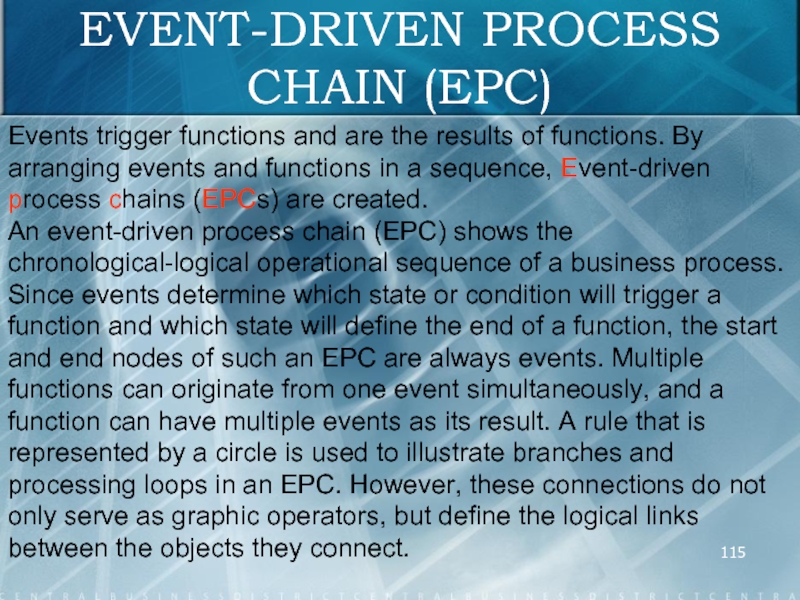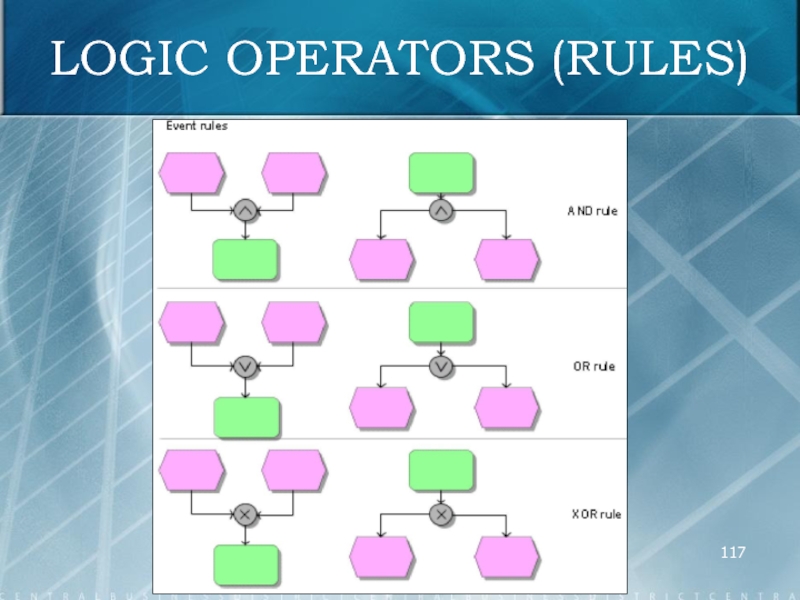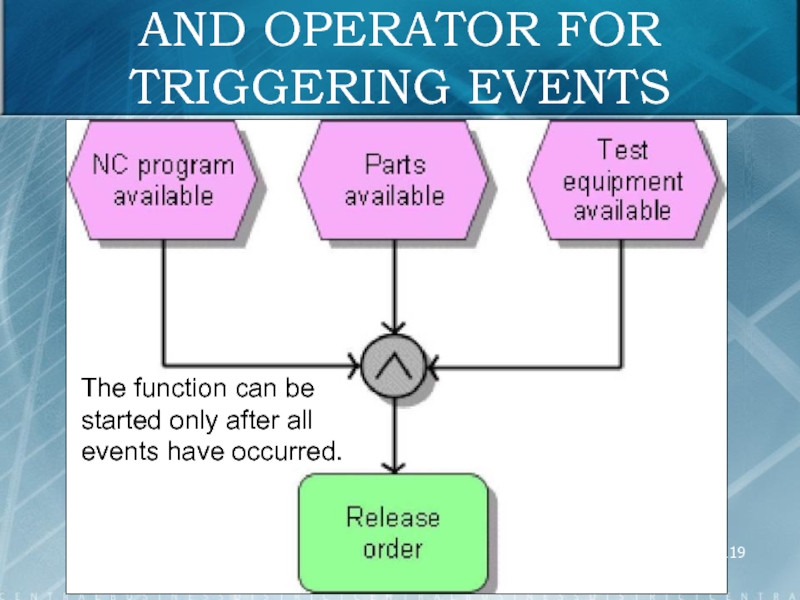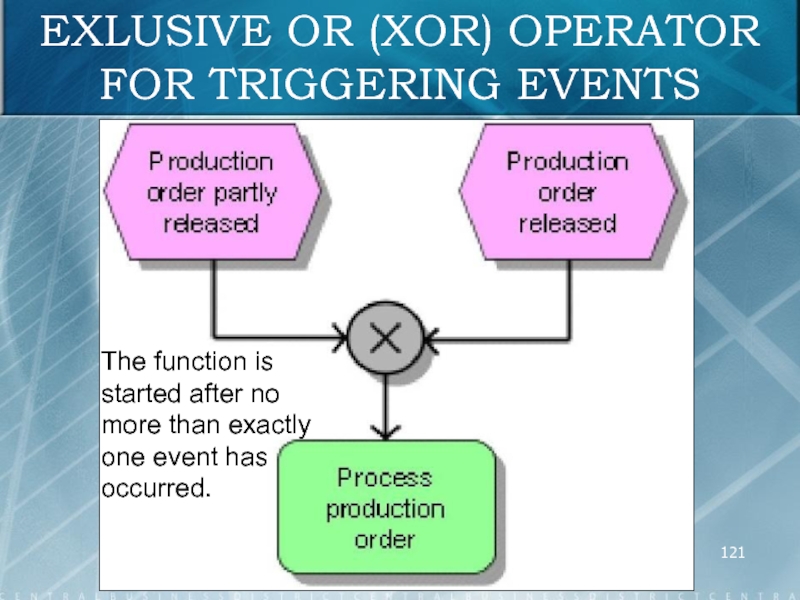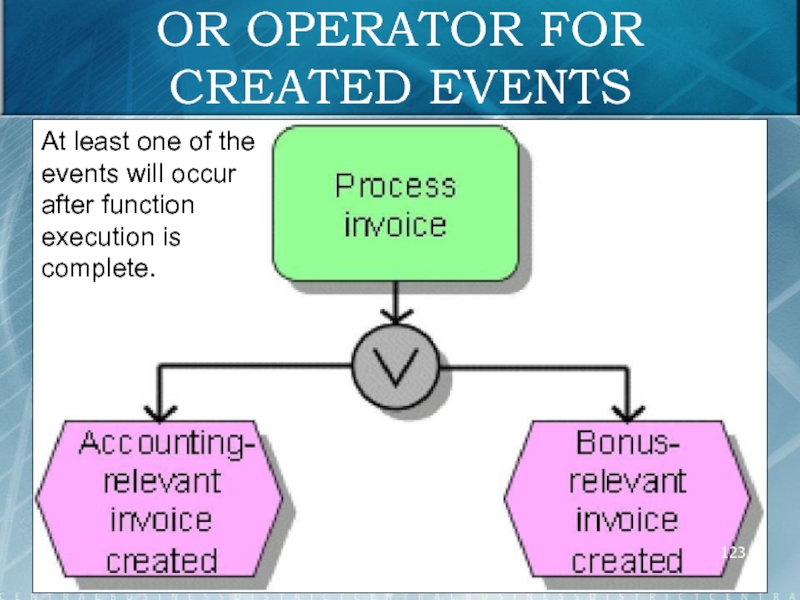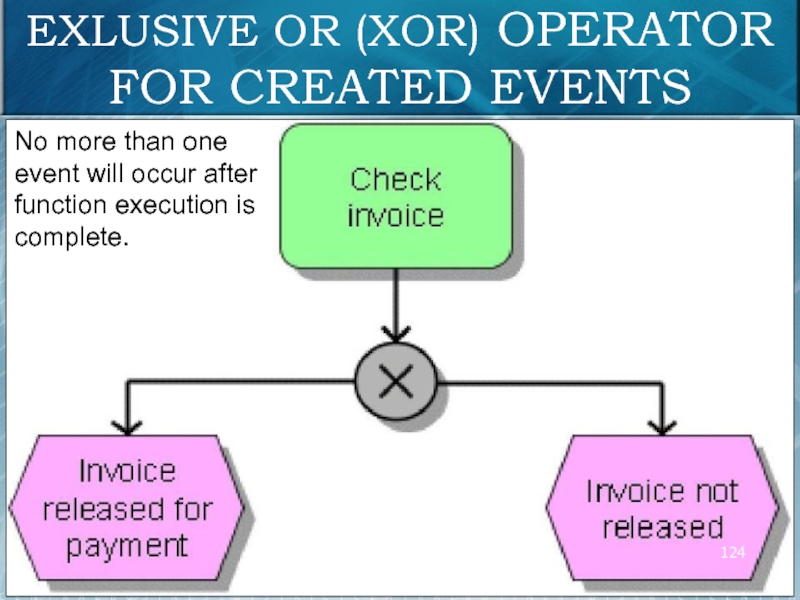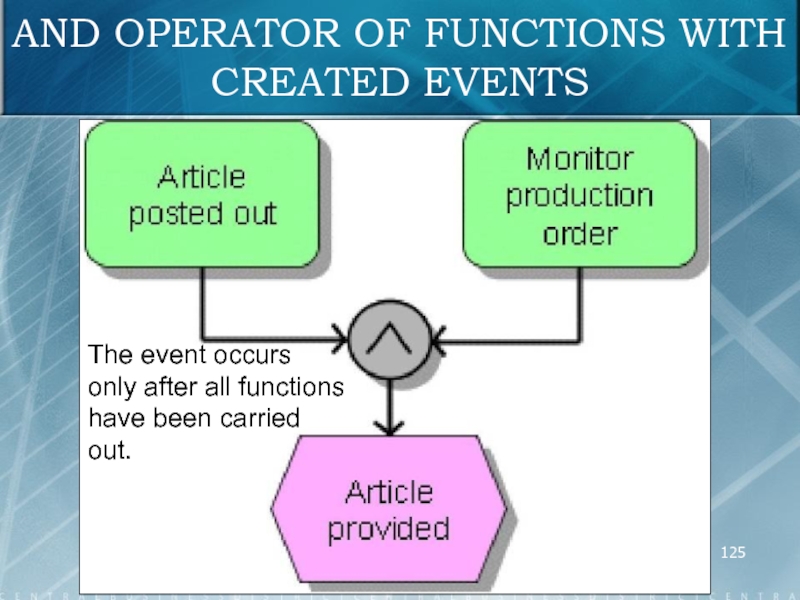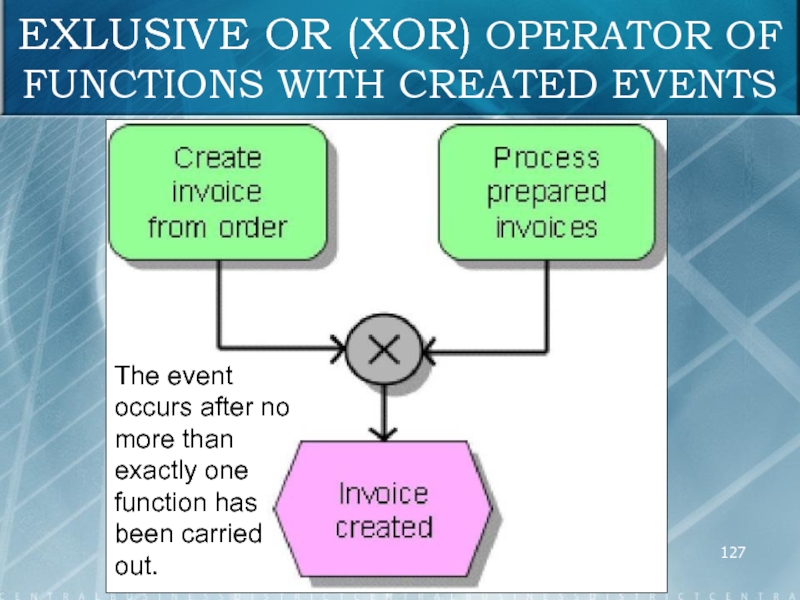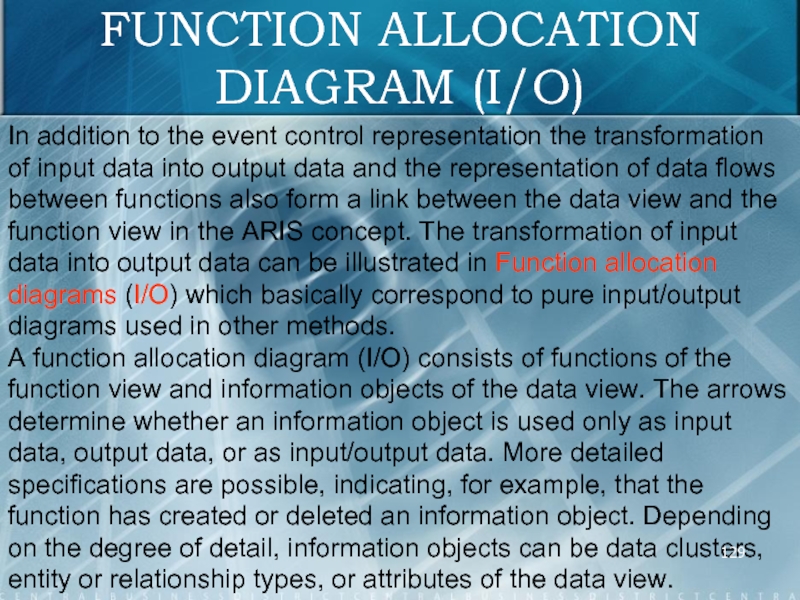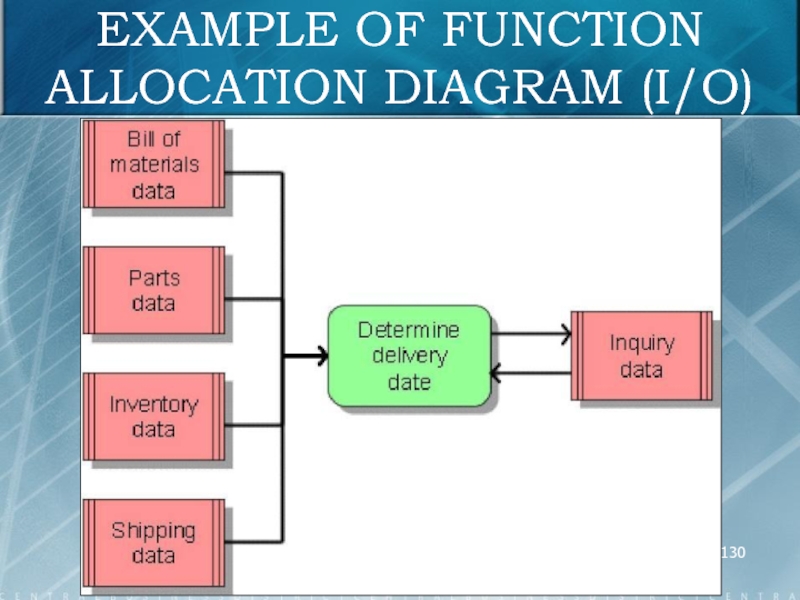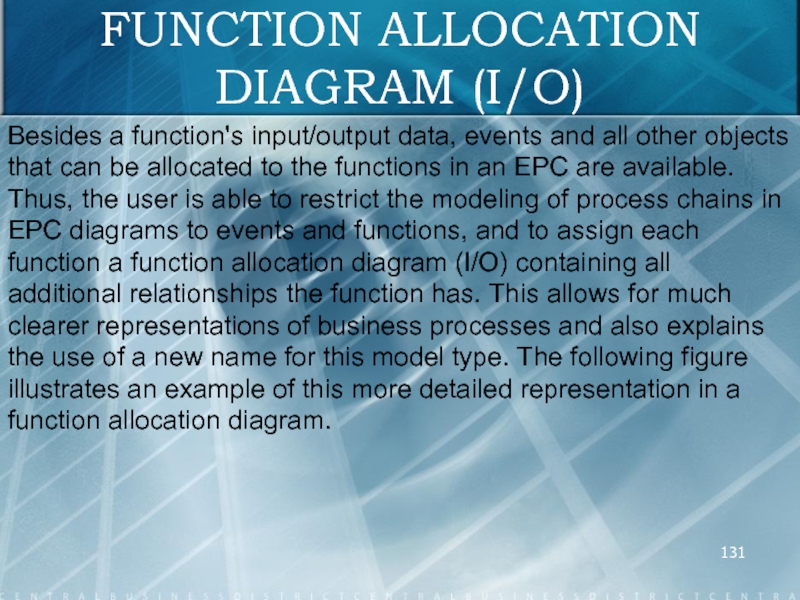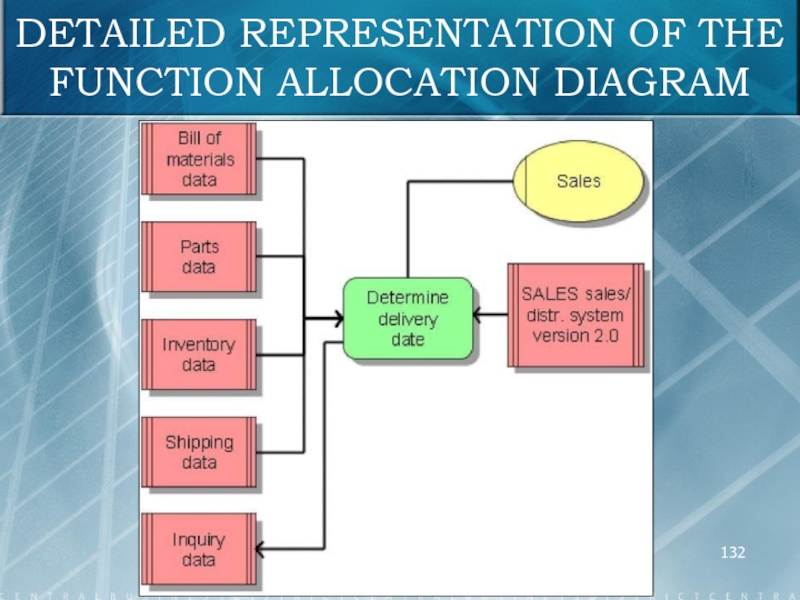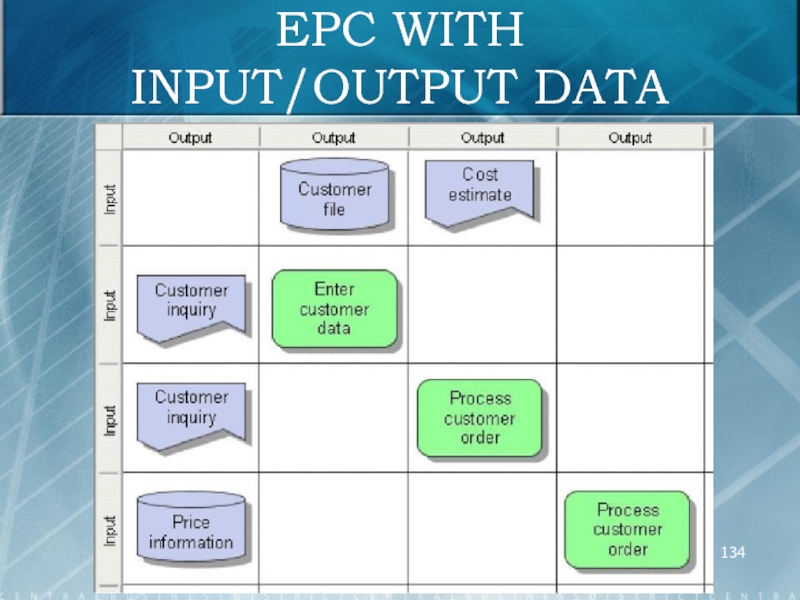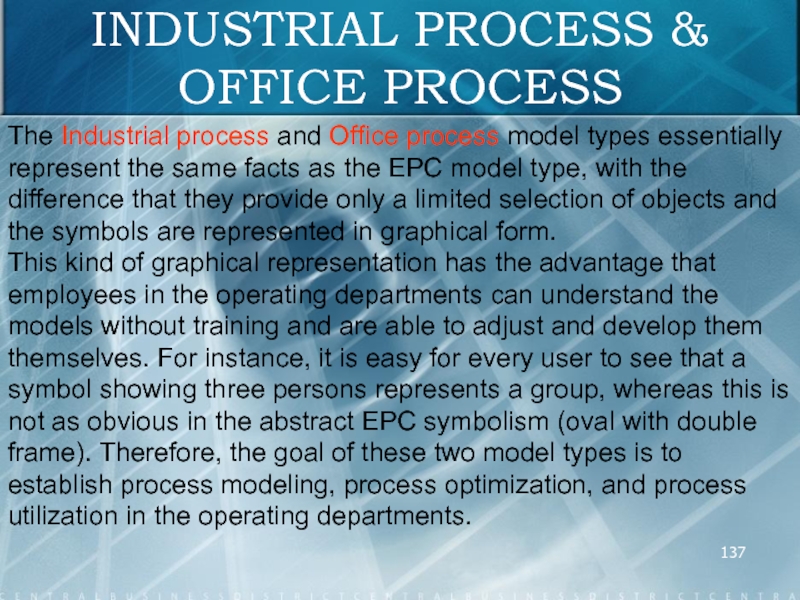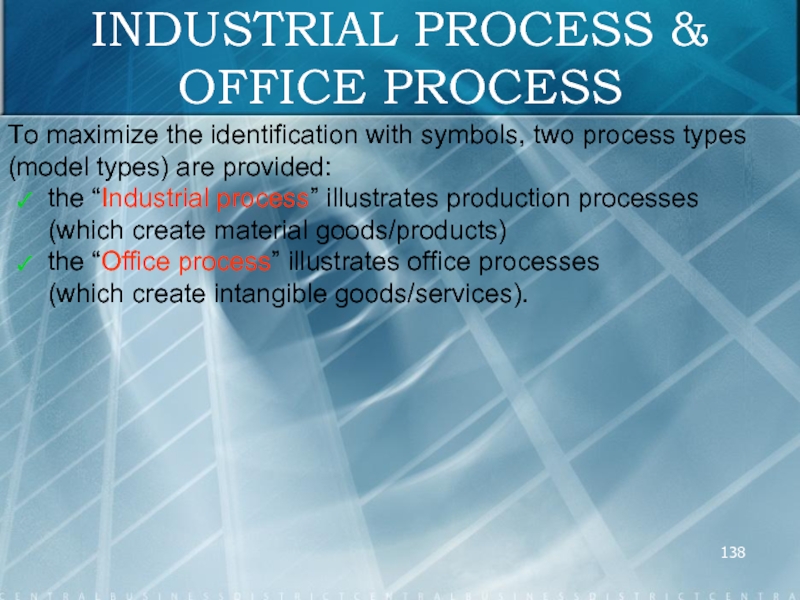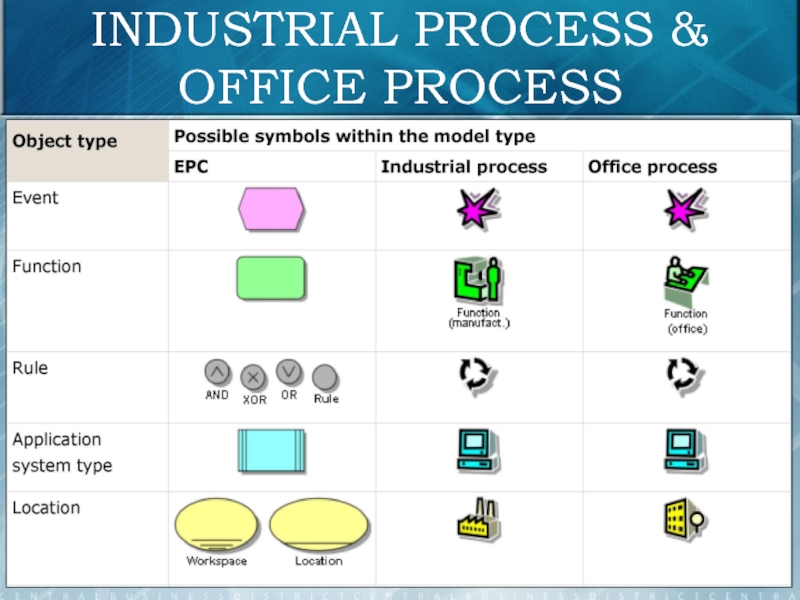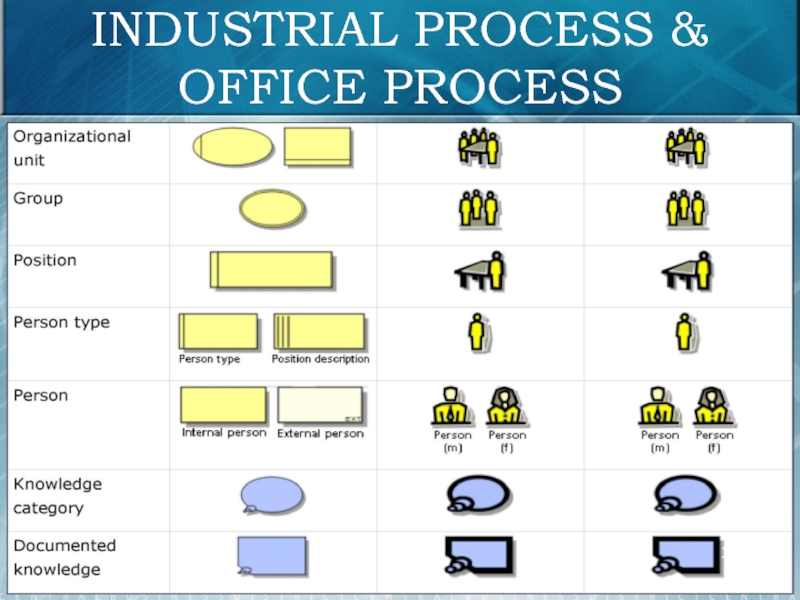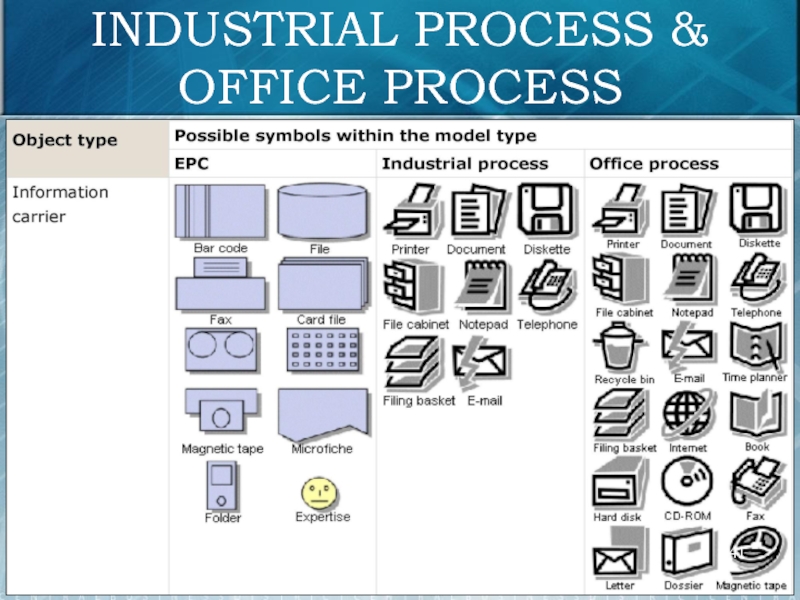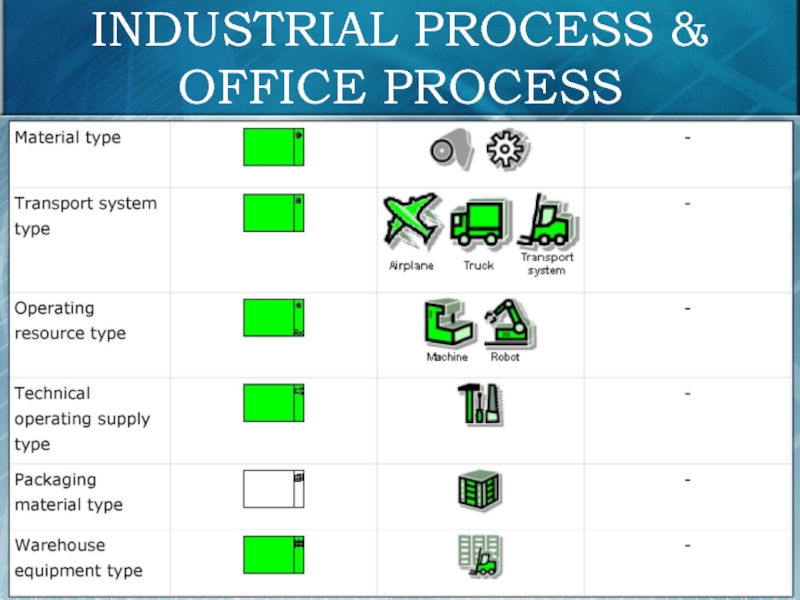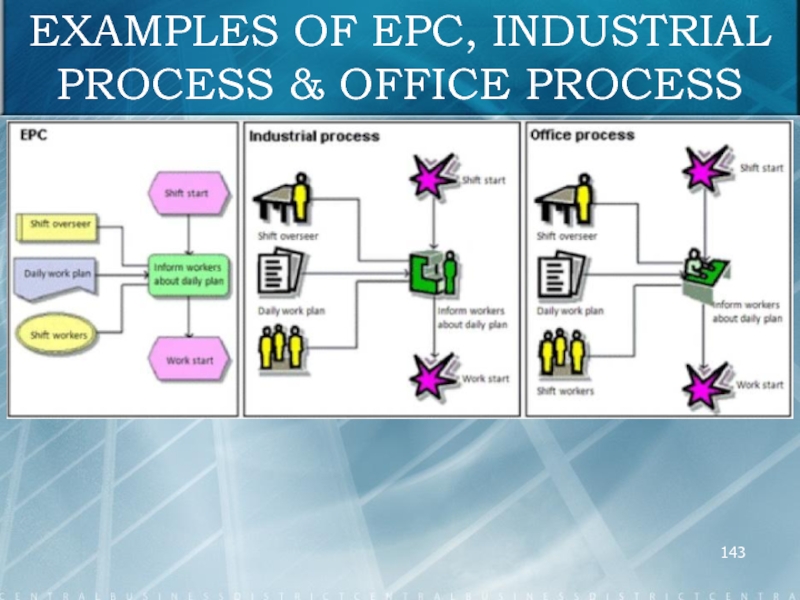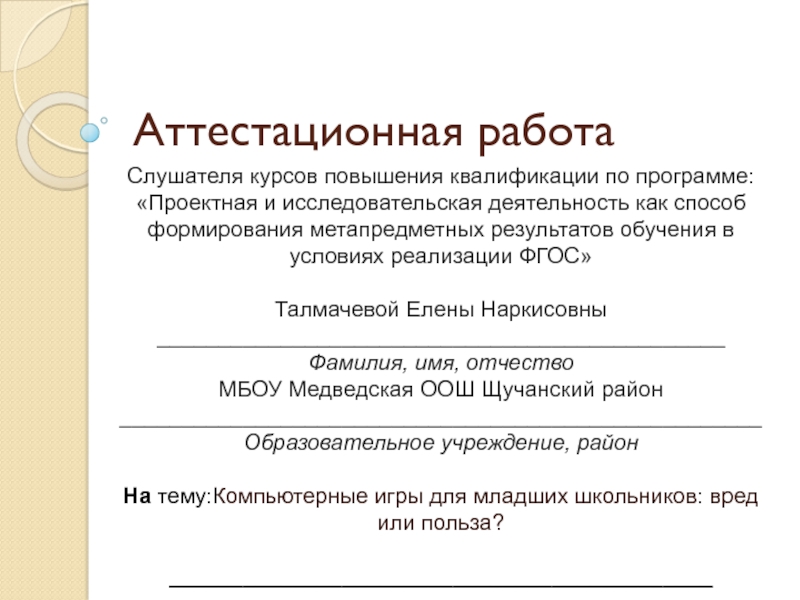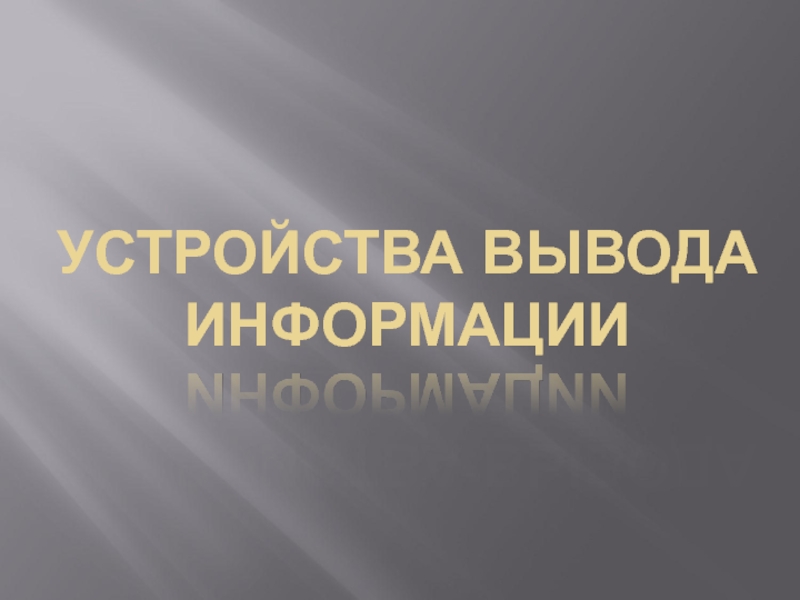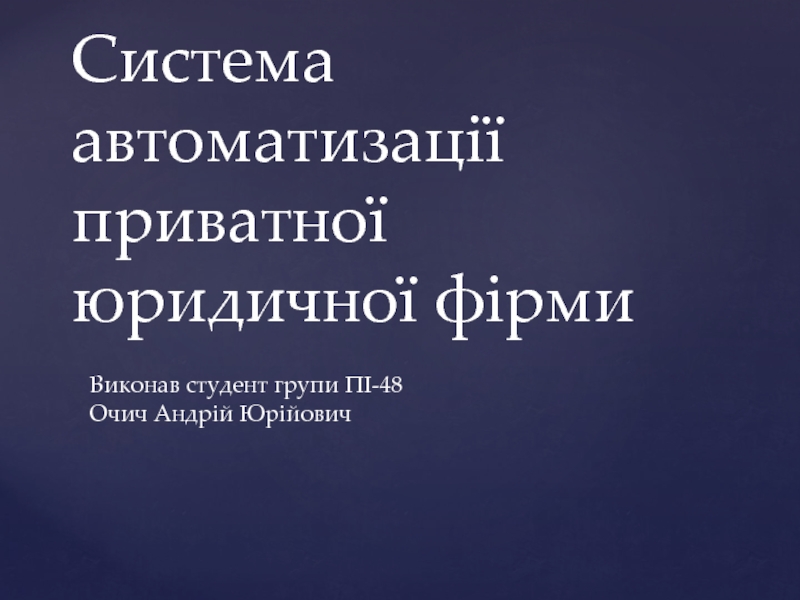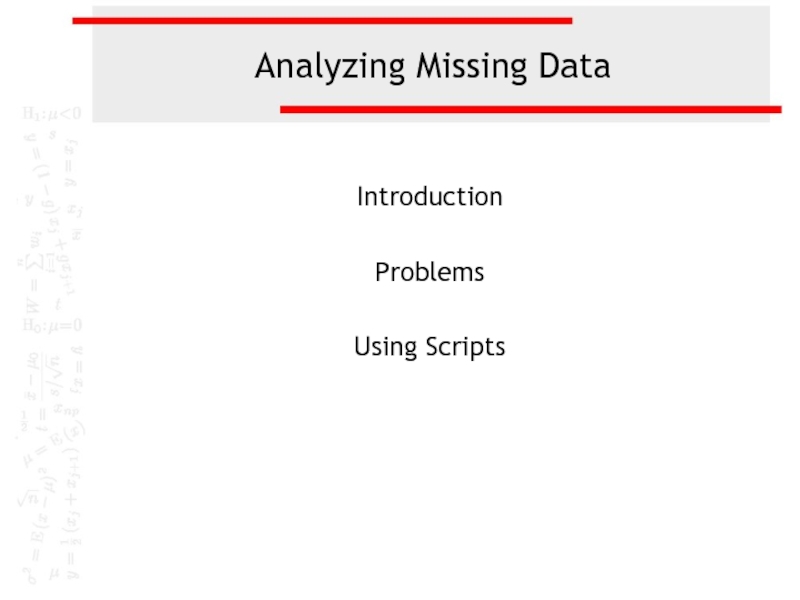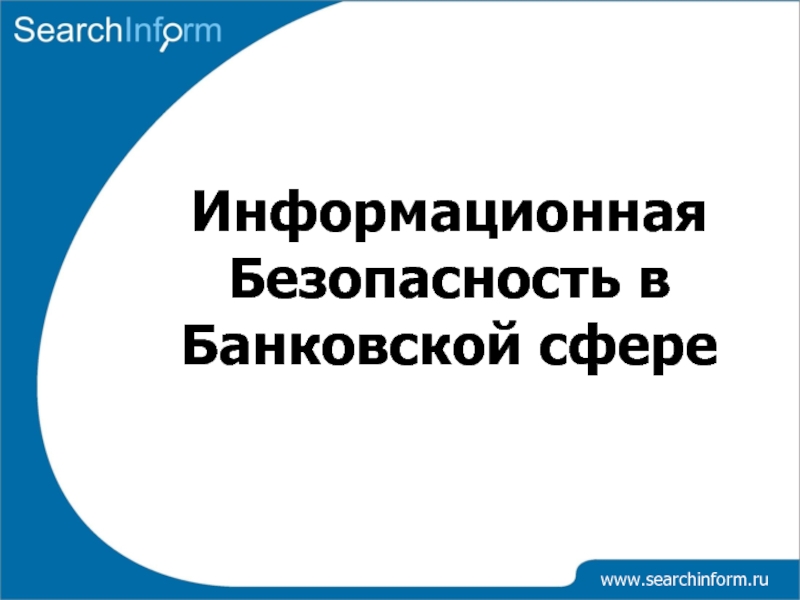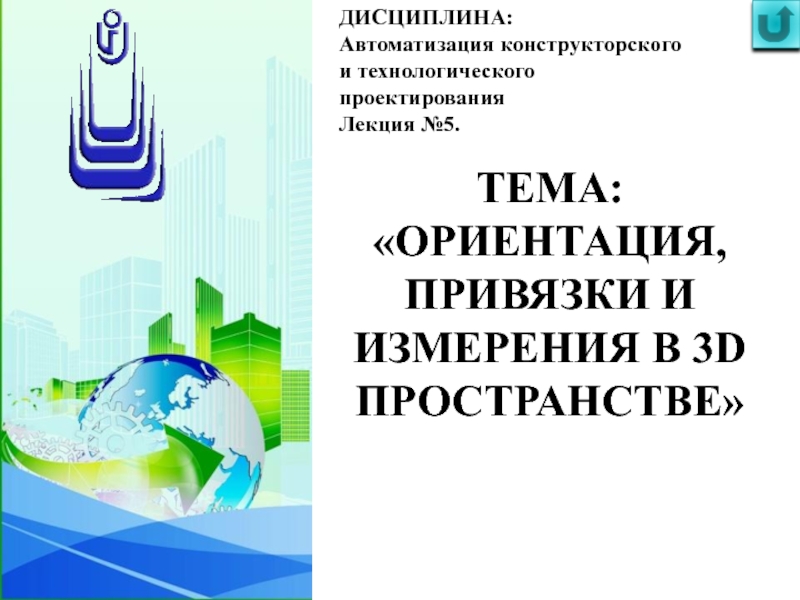- Главная
- Разное
- Дизайн
- Бизнес и предпринимательство
- Аналитика
- Образование
- Развлечения
- Красота и здоровье
- Финансы
- Государство
- Путешествия
- Спорт
- Недвижимость
- Армия
- Графика
- Культурология
- Еда и кулинария
- Лингвистика
- Английский язык
- Астрономия
- Алгебра
- Биология
- География
- Детские презентации
- Информатика
- История
- Литература
- Маркетинг
- Математика
- Медицина
- Менеджмент
- Музыка
- МХК
- Немецкий язык
- ОБЖ
- Обществознание
- Окружающий мир
- Педагогика
- Русский язык
- Технология
- Физика
- Философия
- Химия
- Шаблоны, картинки для презентаций
- Экология
- Экономика
- Юриспруденция
Architecture of integrated information systems (ARIS) презентация
Содержание
- 1. Architecture of integrated information systems (ARIS)
- 2. ARIS ARCHITECTURE CONCEPT The Architecture of integrated
- 3. ARIS ARCHITECTURE CONCEPT A second approach that
- 4. ARIS DESCRIPTIVE VIEWS Product/Service view describes relationships
- 5. ARIS DESCRIPTIVE VIEWS Resource view provides general
- 6. DESCRIPTIONS OF AN INFORMATION SYSTEM
- 7. DESCRIPTION OF THE BUSINESS MANAGEMENT PROBLEM Individual
- 8. PROCESS CHAIN DIAGRAM (PCD) A process chain
- 9. DESIGN ELEMENTS FOR PROCESS CHAIN DIAGRAM
- 10. PROCESS CHAIN DIAGRAM (EXAMPLE)
- 11. FUNCTION VIEW The ARIS architecture strictly separates
- 12. FUNCTION TREE Functions can be described at
- 13. EXAMPLE OF THE FUNCTION TREE
- 14. GROUPING FUNCTIONS Grouping functions within a function
- 15. GROUPING FUNCTIONS (EXAMPLES)
- 16. DESIGN SPECIFICATION – APPLICATION SYSTEM TYPE DIAGRAM
- 17. DESIGN SPECIFICATION – APPLICATION SYSTEM TYPE DIAGRAM
- 18. DESIGN SPECIFICATION – APPLICATION SYSTEM TYPE DIAGRAM
- 19. APPLICATION MODULS TYPE As with application system
- 20. MODULAR STRUCTURE OF AN APPLICATION SYSTEM TYPE
- 21. APPLICATION MODULS TYPE Application system types and
- 22. ALLOCATION OF FUNCTIONS TO APPLICATION SYSTEM TYPES
- 23. APPLICATION SYSTEM TYPE CONFIGURATION To obtain a
- 24. SCREEN AND LIST ASSIGNMENTS Processing a technical
- 25. IMPLEMENTATION – APPLICATION SYSTEM TYPE DIAGRAM In
- 26. ASSIGNMENT OF APPLICATION SYSTEMS TO THEIR APPLICATION SYSTEM TYPES
- 27. DIFFERENT MODULAR STRUCTURE OF TWO APPLICATION SYSTEMS OF THE SAME TYPE
- 28. ASSIGNMENT OF APPLICATION SYSTEM TYPES, PROGRAM MODULE TYPES, AND PROGRAM MODULES
- 29. DATA VIEW The requirements definition of the
- 30. ENTITY-RELATIONSHIP MODEL (ERM) Entity-Relationship Model (ERM) is
- 31. ENTITIES Entities are real or abstract objects
- 32. ATTRIBUTES Attributes are properties describing entity types.
- 33. RELATIONSHIPS A relationship is a logical link
- 34. CARDINALITIES OF RELATIONSHIPS BETWEEN TWO ENTITY TYPES
- 35. CARDINALITIES OF RELATIONSHIPS BETWEEN TWO ENTITY TYPES
- 36. REPRESENTATION OF CARDINALITIES IN THE ERM
- 37. REPRESENTATION OF CARDINALITIES IN THE ERM Due
- 38. REPRESENTATION OF CARDINALITIES IN THE ERM
- 39. eERM EXTENSIONS For extending ERM modeling, four
- 40. CLASSIFICATION Through classification, objects (entities) of the
- 41. GENERALIZATION / SPECIALIZATION Generalization means that similar
- 42. GENERALIZATION / SPECIALIZATION
- 43. AGGREGATION Aggregation is the formation of new
- 44. DATA CLUSTER In an ERM, a complex
- 45. DATA CLUSTER VIEW OF MULTIPLE OBJECTS
- 46. GROUPING Grouping forms groups from the elements
- 47. EXTENSION OF CARDINALITIES When specifying cardinalities, so
- 48. EXTENSION OF CARDINALITIES The upper limit, the
- 49. EXTENSION OF CARDINALITIES Every relationship is defined
- 50. EXTENSION OF CARDINALITIES In the example, the
- 51. TECHNICAL TERMS MODEL Technical terms model can
- 52. TECHNICAL TERMS MODEL
- 53. eERM ATTRIBUTE ALLOCATION DIAGRAM eERM attribute allocation
- 54. SAP SERM The modeling technique developed by
- 55. eERM and SAP SERM REPRESENTATION
- 56. eERM: TERMS AND FORMS REPRESENTATION
- 57. eERM: TERMS AND FORMS REPRESENTATION
- 58. DOCUMENT TYPE DEFINITION A model of the
- 59. MATERIAL FLOW MODELING – MATERIAL DIAGRAM To
- 60. MATERIAL FLOW MODELING – MATERIAL DIAGRAM Packaging
- 61. EXAMPLE OF A MATERIAL DIAGRAM
- 62. MODELING THE DATA WAREHOUSE STRUCTURE The
- 63. DATA WAREHOUSE IN THE STAR SCHEMA
- 64. AUTHORIZATION HIERARCHY The authorization hierarchy diagram is
- 65. AUTHORIZATION HIERARCHY
- 66. COST DRIVER DIAGRAM The CD diagram (cost
- 67. COST DRIVER DIAGRAM Cost drivers can be
- 68. COST DRIVER DIAGRAM
- 69. COST CATEGORY DIAGRAM The cost category diagram
- 70. COST CATEGORY DIAGRAM
- 71. RELATIONS DIAGRAM In the design specification, the
- 72. RELATIONS DIAGRAM In a first step, the
- 73. RELATIONS DIAGRAM In a second step, the
- 74. ALLOCATION OF THE REQUIREMENTS DEFINITION ATTRIBUTES AND DATA OBJECTS
- 75. ATTRIBUTE ALLOCATION DIAGRAM To reduce representation complexity,
- 76. LOGICAL VIEW OF MULTIPLE RELATIONS The data
- 77. SYSTEM ATTRIBUTES MODEL The System attributes model
- 78. EXAMPLE OF A “SYSTEM ATTRIBUTES” MODEL
- 79. SYSTEM ATTRIBUTE DOMAIN The System attribute domain
- 80. TABLE DIAGRAM The table diagram is used
- 81. FIELD ALLOCATIONS
- 82. ALLOCATION OF REQUIREMENTS DEFINITION AND DESIGN SPECIFICATION
- 83. Due to the fact that converting or
- 84. ALLOCATION OF REQUIREMENTS DEFINITION AND DESIGN SPECIFICATION OBJECTS
- 85. To be able to define the exact
- 86. TABLE SPECIMENS
- 87. Companies are complex social structures that are
- 88. The design of an ideal company organization
- 89. A typical way of representing organizational structures
- 90. The Position object type is provided to
- 91. ORGANIZATIONAL CHART WITH POSITION AND PERSON ASSIGNMENT
- 92. PERSON TYPES Using these object types enables
- 93. LOCATION ASSIGNMENTS The modeling of the organizational
- 94. LOCATION ASSIGNMENTS
- 95. LOCATION HIERARCHIES
- 96. SHIFT CALENDAR A shift calendar is the
- 97. NETWORK TOPOLOGY The structural requirements for these
- 98. NETWORK TOPOLOGY The link between network topology
- 99. NETWORK TOPOLOGY
- 100. NETWORK DIAGRAM The network diagram illustrates the
- 101. NETWORK DIAGRAM WITH LOCATION ASSIGNMENT
- 102. NETWORK DIAGRAM WITH HARDWARE COMPONENTS AND LOCATION ASSIGNMENT
- 103. MATERIAL FLOW MODELING – TECHNICAL RESOURCES To
- 104. MATERIAL FLOW MODELING – TECHNICAL RESOURCES In
- 105. MATERIAL FLOW MODELING – TECHNICAL RESOURCES Operating
- 106. MATERIAL FLOW MODELING – TECHNICAL RESOURCES Warehouse
- 107. MATERIAL FLOW MODELING – TECHNICAL RESOURCES Technical
- 108. MATERIAL FLOW MODELING – TECHNICAL RESOURCES Transport
- 109. EXAMPLE OF A “TECHNICAL RESOURCES” MODEL
- 110. PROCESS VIEW / CONTROL VIEW The relationships
- 111. LINKING FUNCTIONS WITH ORGANIZATION Linking the function
- 112. ALLOCATION OF ORGANIZATIONAL ELEMENTS TO FUNCTIONS
- 113. EVENT-DRIVEN PROCESS CHAIN (EPC) Linking the function
- 114. EVENTS The operational sequence of functions in
- 115. EVENT-DRIVEN PROCESS CHAIN (EPC) Events trigger functions
- 116. EVENT-DRIVEN PROCESS CHAIN (EPC)
- 117. LOGIC OPERATORS (RULES)
- 118. LOGIC OPERATORS (RULES)
- 119. AND OPERATOR FOR TRIGGERING EVENTS The function
- 120. OR OPERATOR FOR TRIGGERING EVENTS The function
- 121. EXLUSIVE OR (XOR) OPERATOR FOR TRIGGERING EVENTS
- 122. AND OPERATOR FOR CREATED EVENTS All events will occur after function execution is complete.
- 123. OR OPERATOR FOR CREATED EVENTS At least
- 124. EXLUSIVE OR (XOR) OPERATOR FOR CREATED EVENTS
- 125. AND OPERATOR OF FUNCTIONS WITH CREATED EVENTS
- 126. OR OPERATOR OF FUNCTIONS WITH CREATED EVENTS
- 127. EXLUSIVE OR (XOR) OPERATOR OF FUNCTIONS WITH
- 128. AND OPERATOR OF FUNCTIONS WITH TRIGGERING EVENTS
- 129. FUNCTION ALLOCATION DIAGRAM (I/O) In addition to
- 130. EXAMPLE OF FUNCTION ALLOCATION DIAGRAM (I/O)
- 131. FUNCTION ALLOCATION DIAGRAM (I/O) Besides a function's
- 132. DETAILED REPRESENTATION OF THE FUNCTION ALLOCATION DIAGRAM
- 133. EPC WITH INPUT/OUTPUT DATA Besides this method
- 134. EPC WITH INPUT/OUTPUT DATA
- 135. EPC WITH INPUT/OUTPUT DATA In the PCD
- 136. EPC WITH INPUT/OUTPUT DATA
- 137. INDUSTRIAL PROCESS & OFFICE PROCESS The Industrial
- 138. INDUSTRIAL PROCESS & OFFICE PROCESS To maximize
- 139. INDUSTRIAL PROCESS & OFFICE PROCESS
- 140. INDUSTRIAL PROCESS & OFFICE PROCESS
- 141. INDUSTRIAL PROCESS & OFFICE PROCESS
- 142. INDUSTRIAL PROCESS & OFFICE PROCESS
- 143. EXAMPLES OF EPC, INDUSTRIAL PROCESS & OFFICE PROCESS
Слайд 2ARIS
ARCHITECTURE CONCEPT
The Architecture of integrated Information Systems (ARIS) is based on
The first step in creating the architecture is to develop a business process model containing all basic features for describing business processes. The result is a highly complex model, which is broken down into individual views so that its complexity is reduced. Due to this breakdown, it is possible to describe the content of individual views by special methods suitable for a specific view without having to pay attention to the numerous view interrelationships. The relationships between the views are incorporated in a final step and combined to form an overall overview of process chains without any redundancies.
Слайд 3ARIS
ARCHITECTURE CONCEPT
A second approach that also reduces complexity is a differentiation
Thus, the ARIS concept is a framework for developing and optimizing integrated information systems and for describing their implementation. As the emphasis lies on the technical descriptive level, the ARIS concept serves as a model for creating, analyzing, and evaluating business management process chains.
Слайд 4ARIS DESCRIPTIVE VIEWS
Product/Service view describes relationships between products/services.
Function view contains the
Organization view subsumes users and organizational units, as well as their relationships and structures.
Слайд 5ARIS DESCRIPTIVE VIEWS
Resource view provides general conditions for describing other components
Control view is provided as an additional view for describing the relationships between views. Combining these relationships in a separate view allows for systematic and redundancy-free recording of all relationships. The control view is an essential component of ARIS which distinguishes it from other architecture approaches.
Слайд 7DESCRIPTION OF THE BUSINESS MANAGEMENT PROBLEM
Individual objects or areas of consideration
The description mentions the weak points that information systems currently used do have in terms of the support they provide for existing business processes and also includes the main content of the target concept for the system to be developed. The target concept in turn reflects the objectives pursued by using new information systems.
The model uses for describing the business management problem must have the ability of recording as many facts as possible from the data, function, and organization views, including their interrelationships.
Слайд 8PROCESS CHAIN DIAGRAM (PCD)
A process chain diagram represents a closed process
All views of a business process (organization view, data view, function view, resource view) are expressed with their relationships in a coherent form.
The two columns on the left represent the chronological-logical operational sequence of the business process under consideration. Individual functions of the procedure are listed in the second column and linked to the events by which they are triggered and which they generate. The connections between functions and events define exactly which events trigger functions and which events are generated by functions and thus regulate the control flow between functions.
Слайд 11FUNCTION VIEW
The ARIS architecture strictly separates the various areas of consideration.
A function is a technical task or activity performed for an object to support one or more business objectives. Mostly a noun is used as the function name. Functions are displayed as rectangles with rounded corners:
Check order
Слайд 12FUNCTION TREE
Functions can be described at different aggregation levels. Accumulations of
A business process thus represents a complex function that can be broken down into subfunctions to reduce its complexity.
The term “function” can be used at all hierarchy levels. However, other terms, such as procedure, process, subfunction, or elementary function, are also used to indicate the hierarchy level.
Breaking down functions can be done across multiple hierarchy levels.
Elementary functions represent the lowest level in semantic function trees. Elementary functions are functions that, from the business management point of view, cannot be broken down any further.
Слайд 14GROUPING FUNCTIONS
Grouping functions within a function tree can be performed according
object-oriented – processing of the same object
process-oriented – breakdown according to process affiliation (is recommended for function trees that represent the results of business process modeling)
execution-oriented – means that all functions performing the same operation for different information objects are grouped together
Слайд 16DESIGN SPECIFICATION – APPLICATION SYSTEM TYPE DIAGRAM
The design specification of the
How can application system types, module types, or IT functions support the functions defined in the requirements definition?
What is the modular structure of application system types or module types?
Which lists and screens are required to carry out a function?
Слайд 17DESIGN SPECIFICATION – APPLICATION SYSTEM TYPE DIAGRAM
Which lists can be created
What technology (operating system, user interface, database management system) is an application system type based on?
Which business objectives are pursued when a specific application system type is used?
Слайд 18DESIGN SPECIFICATION – APPLICATION SYSTEM TYPE DIAGRAM
The Application system type is
Application system types are represented by the following graphic symbol:
Слайд 19APPLICATION MODULS TYPE
As with application system types, module types typify individual
Слайд 21APPLICATION MODULS TYPE
Application system types and module types can be arranged
An IT function type, in the sense of a transaction, is the smallest unit of a module type. IT function types are realized as individual program modules and must always be carried out completely to process an individual work step. Graphical representation of an IT function type:
Слайд 22ALLOCATION OF FUNCTIONS TO APPLICATION SYSTEM TYPES
The application system type
Слайд 23APPLICATION SYSTEM TYPE CONFIGURATION
To obtain a more detailed specification of the
Слайд 24SCREEN AND LIST ASSIGNMENTS
Processing a technical function with the support of
Слайд 25IMPLEMENTATION – APPLICATION SYSTEM TYPE DIAGRAM
In the application system type diagram
An application system (module) is an individual specimen of an application system type (module type), which can be uniquely identified, e.g., by the license number.
Application systems and modules are displayed graphically:
Слайд 29DATA VIEW
The requirements definition of the data view includes a description
Unlike function modeling, data modeling is particularly demanding as far as the method is concerned. In the function view, the only object examined is the function. Furthermore, relationships between functions simply illustrate superordination or subordination.
Слайд 30ENTITY-RELATIONSHIP MODEL (ERM)
Entity-Relationship Model (ERM) is the most widely used designing
Слайд 31ENTITIES
Entities are real or abstract objects that are relevant for the
Entities are described in more detail by means of specific attributes (properties). For example, a customer can be specified more precisely by his name, first name, and address. If similar entities are grouped into sets, these are referred to as entity types, the individual occurrences of which are the entities.
Entities of a similar type can be described by the same attributes. Entity types are displayed as rectangles.
Слайд 32ATTRIBUTES
Attributes are properties describing entity types. Attribute occurrences are specific values
Attributes are usually represented by an oval or a circle.
Слайд 33RELATIONSHIPS
A relationship is a logical link between entities. Therefore, the existence
Слайд 34CARDINALITIES OF RELATIONSHIPS BETWEEN TWO ENTITY TYPES
Four different types of relationships
1:1 relationship – each entity of the first set is assigned to exactly one entity of the second set
1:n relationship – each entity of the first set is assigned to exactly one entity of the second set, but each entity of the second set may be connected with various entities of the first set
n:1 relationship – means the same, but in reverse order
n:m relationship – multiple entities of the second set are assigned to each entity of the first set and vice versa
Слайд 37REPRESENTATION OF CARDINALITIES IN THE ERM
Due to the fact that relationships
Слайд 39eERM EXTENSIONS
For extending ERM modeling, four basic design operators have become
Classification
Generalization
Aggregation
Grouping
Слайд 40CLASSIFICATION
Through classification, objects (entities) of the same type are identified and
Слайд 41GENERALIZATION /
SPECIALIZATION
Generalization means that similar object types are grouped under a
Properties (described by attributes) that both source objects share are transferred to the generalized object type. Thus, only those attributes in which the source object types differ are left to be described. The formation of the new entity type is graphically represented by a triangle, also called an ”is a” relationship.
Specialization is the breakdown of a generic term into subterms.
Specialization is the reverse of generalization. The specialized objects inherit the properties of the generalized object. Apart from these inherited attributes, the specialized object types may have their own attributes. Graphically, specialization and generalization are represented in the same way. For this reason, the links are not drawn as arrows indicating a direction.
Слайд 43AGGREGATION
Aggregation is the formation of new object types by combining existing
In the ERM, aggregation is expressed by the formation of relationship types.
The aggregation operator can also be applied to relationships. An existing relationship type is then treated as an entity type and can thus become the starting point for creating new relationships.
Слайд 44DATA CLUSTER
In an ERM, a complex structural context is split into
A data cluster is the logical view of multiple entity types and relationship types of a data model that are required for describing a complex object.
Besides entity types and relationship types, data clusters themselves can be part of a data cluster, too. Unlike entity and relationship types, data clusters can be arranged in any hierarchy and thus mainly support a top-down procedure in the process of creating data models. However, forming data clusters may also be very helpful when combining and consolidating submodels during a bottom-up approach.
Слайд 46GROUPING
Grouping forms groups from the elements of an entity set.
For example,
Слайд 47EXTENSION OF CARDINALITIES
When specifying cardinalities, so far only the upper limit
For example, the cardinalities indicate that a project can be assigned a maximum number (m) of employees and one employee can participate in a maximum number (n) of projects.
Слайд 48EXTENSION OF CARDINALITIES
The upper limit, the lower limit specifying the minimum
For this purpose, the cardinalities can be expressed as a letter pair (a, b). The letter pair (a1, b1) in the following figure indicates that every project can participate in at least a1 and at most b1 relationship occurrences of the works in type, which means that every project can be assigned at least a1 and at most b1 employees. The other letter pair (a2, b2) indicates that one employee can participate in at least a2 and in at most b2 projects.
Слайд 49EXTENSION OF CARDINALITIES
Every relationship is defined by two degrees of complexity
A lower limit of min = 0 means that an entity may participate in a relationship, but does not necessarily have to.
A lower limit of min = 1 indicates that an entity must participate in at least one relationship.
Слайд 50EXTENSION OF CARDINALITIES
In the example, the lower limits indicate that an
Слайд 51TECHNICAL TERMS MODEL
Technical terms model can be used to manage the
Technical terms can be interrelated and may be arranged in a hierarchy.
Слайд 53eERM ATTRIBUTE ALLOCATION DIAGRAM
eERM attribute allocation diagrams enable to assign ERM
Слайд 54SAP SERM
The modeling technique developed by SAP AG. In this context,
Hierarchical relationships define a unilateral existence dependency between information objects. Aggregating relationships correspond to the formation of relationship types based on the eERM approach.
Referential relationships describe logical dependencies between reinterpreted entity types and original entity types based on the eERM approach.
Specialization is represented in analogy to the ERM approach.
Слайд 58DOCUMENT TYPE DEFINITION
A model of the DTD (Document Type Definition) type
A DTD can be used to define the general structure of a document type. A valid document of a document type defined in the DTD can be created as an XML document. This has the advantage that the document can be processed by various programs based on the corresponding DTD.
Слайд 59MATERIAL FLOW MODELING – MATERIAL DIAGRAM
To illustrate the material flow in
In the material diagram, can be defined material types, arranged them in a hierarchy, and assigned them to material classes.
A material type typifies individual materials with identical material properties.
Similar material types can be combined to form a material class. The similarity can be based on different classification criteria. Thus, a material type can be assigned to multiple material classes. Material types can be assigned to packaging material types. This indicates that certain material types can only be transported in specific packaging material types.
Слайд 60MATERIAL FLOW MODELING – MATERIAL DIAGRAM
Packaging material types can also be
A packaging material type typifies individual packaging materials with identical properties (e. g., material properties).
Similar packaging material types can be combined to form a packaging material class. The similarity can be based on different classification criteria. Thus, a packaging material type can be assigned to multiple packaging material classes.
Слайд 62MODELING THE DATA WAREHOUSE STRUCTURE
The Data Warehouse structure diagram describes
Слайд 64AUTHORIZATION HIERARCHY
The authorization hierarchy diagram is used in role modeling and
The authorization hierarchy diagram is closely associated with the role diagram. The authorizations listed are used in the role description to define the requirements profile. The structure corresponds to that of a function tree.
Слайд 66COST DRIVER DIAGRAM
The CD diagram (cost driver diagram) is used in
The CD diagram represents the cost driver hierarchy.
A cost driver is an informative indicator or reference value for estimating the costs of a specific process. The reference value should be an operational value that can be easily derived from available information sources and is proportional to accruing costs.
Слайд 67COST DRIVER DIAGRAM
Cost drivers can be defined only for performance amount-variable
The hierarchy of cost drivers is represented in the CD diagram by directed connections of the determines volume of type.
The CD ratio numerator and CD ratio denominator attributes must be specified for these connections.
If CD ratio denominator is not specified, a value of 1 is assumed. The quotient of these two attributes determines the quantity ratio between the two cost drivers for process calculation.
Слайд 69COST CATEGORY DIAGRAM
The cost category diagram is used in process cost
Cost categories serve to systematically structure all costs that arise from the creation and utilization of cost objects.
The question is: What costs have been incurred?
The hierarchy of cost categories is illustrated in the cost category diagram by directed connections of the is superior type.
An important attribute for cost categories is performance scale. It describes the unit in which cost category performance is measured (e.g., hours for wages and square meters for occupancy costs).
Слайд 71RELATIONS DIAGRAM
In the design specification, the logical data structures designed in
The relations diagram and the attribute allocation diagram are available to define existing relations and attributes including their relationships to the information objects introduced in the requirements definition.
Слайд 72RELATIONS DIAGRAM
In a first step, the required relations are defined in
A relation describes an entity type through its attributes. A relation is a subset of possible value range combinations of individual attributes.
Every eERM entity type now constitutes a relation in the relations diagram. When realizing relationship types of an eERM, the cardinality is a very important factor in deciding whether or not to create a separate relation for the relationship type.
Unlike 1:n relations, n:m relations must be represented in separate relations.
Слайд 73RELATIONS DIAGRAM
In a second step, the relations diagram can indicate for
A relation can be specified in more detail by listing its attributes. Whether the corresponding attribute serves as a key attribute, foreign key attribute, or descriptive attribute may be defined by specifying the relevant connection when linking the relation and the attribute. Also, the relationship of every single attribute to the ERM attribute of the requirements definition it illustrates can be established.
Слайд 75ATTRIBUTE ALLOCATION DIAGRAM
To reduce representation complexity, the attributes of every relation
Слайд 76LOGICAL VIEW OF MULTIPLE RELATIONS
The data clusters of the requirements definition
Based on the definition of data clusters, “View” is defined as: A “View” is the logical view of multiple relations.
Слайд 77SYSTEM ATTRIBUTES MODEL
The System attributes model type is primarily designed to
To determine the domain types of these data objects, you can assign the System attribute domain model type.
In contrast to ERM attributes, the main feature of system attributes is the representation and management of interface-oriented data. To ensure high flexibility in terms of the contents to be exported, the system attribute objects contain two value fields that can be filled with relevant information.
Слайд 79SYSTEM ATTRIBUTE DOMAIN
The System attribute domain model type is used to
Слайд 80TABLE DIAGRAM
The table diagram is used to describe the tables and
The individual fields assigned to this table can be shown for each table. For further specification, a sorting index and the domain can be assigned to each field.
Слайд 82ALLOCATION OF
REQUIREMENTS DEFINITION AND
DESIGN SPECIFICATION OBJECTS
As relations of a relations diagram
Слайд 83Due to the fact that converting or documenting database tables and
The representation may focus either on the relations and attributes realized by the tables and fields, or – leaving out the relational definitions – on the entity types, relationship types, and ERM attributes illustrated by the tables and fields.
ALLOCATION OF
REQUIREMENTS DEFINITION AND
DESIGN SPECIFICATION OBJECTS
Слайд 85To be able to define the exact location of specific tables
The Table object type introduced earlier determines the logical structure of a physical table and its fields at the Type level. However, multiple specimens of every table thus defined may exist on different media or at different locations in a company. This fact can be represented using the Table (specimen) and Field (specimen) object types.
With the help of these objects, the specimen count of a table or
a field can be determined exactly.
TABLE SPECIMENS
Слайд 87Companies are complex social structures that are divided into manageable units.
In a company's organizational design, a distinction can be made between the organizational structure and the process organization.
The organizational structure encompasses the rules by which the company is statically structured. The process organization contains the rules relating to the tasks to be performed by the company. This task-related structure in the sense of distributing functions to task performers is dealt with in the control view of the ARIS house. The organization view basically looks at a company's organizational structure.
ORGANIZATION VIEW
Слайд 88The design of an ideal company organization with the aim of
Both the design and use of information systems had their focus on this functional breakdown of companies for a long time. However, looking at integrated process chains in the sense of cohesive processing of similar data objects makes it difficult to establish interrelationships between individual functions for such a structural design.
ORGANIZATION VIEW
Слайд 89A typical way of representing organizational structures is the organizational chart.
Organizational units are the performers of the tasks that must be carried out in order to achieve the business objectives.
Organizational units are linked via relationships.
ORGANIZATION CHART
Слайд 90The Position object type is provided to represent individual positions within
Individual persons in the company can be assigned to the positions and organizational units. ARIS offers separate objects for persons. The assignment of an individual person to an organizational unit shows that this person is assigned as an employee to this organizational unit, whereas the assignment to an individual position defines the current staffing in the company.
ORGANIZATIONAL CHART WITH
POSITION AND PERSON ASSIGNMENT
Слайд 92PERSON TYPES
Using these object types enables to depict general business rules
Слайд 93LOCATION ASSIGNMENTS
The modeling of the organizational structure of the company is
The location of an organizational unit is the most important link between requirements definition and design specification of the organization view. Thus, the location of every organizational unit is already defined in the requirements definition.
Locations may be arranged in any required hierarchy. A location can be an entire plant, a building or, for a more detailed examination, an office through to an individual workstation in a room.
Слайд 96SHIFT CALENDAR
A shift calendar is the total number of shift cycles
Слайд 97NETWORK TOPOLOGY
The structural requirements for these information systems can generally be
In a first step, various network types can be incorporated in a Network topology model.
A network type typifies individual network specimens that are based on precisely the same technology.
Слайд 98NETWORK TOPOLOGY
The link between network topology and the objects of the
For every single hardware component type the organizational unit or position responsible for it can be specified.
It is possible to define for each network type, network node type, network connection type, and hardware component type at which location within the company they may be found. Thus, the location is the central link between the requirements definition and the design specification of the organization view.
Слайд 100NETWORK DIAGRAM
The network diagram illustrates the realization of the network topology
The networks that exist in the company are recorded by means of the Network object. It is possible to specify for each network the network nodes and network connections it consists of. The exact location of every network, network node, and network connection within the company can be indicated. A location can be an entire plant, a specific building, a complex of buildings, an office, or an individual workstation.
Слайд 103MATERIAL FLOW MODELING – TECHNICAL RESOURCES
To illustrate the material flow in
Слайд 104MATERIAL FLOW MODELING – TECHNICAL RESOURCES
In the Technical resources model type
Operating resource. Operating resources are specimens of various operating resource types that are available for a company to perform its tasks. Operating resources are often identified by inventory numbers (e.g., number of a production plant).
Operating resource type. An operating resource type typifies individual operating resources that are based on precisely the same technology.
Слайд 105MATERIAL FLOW MODELING – TECHNICAL RESOURCES
Operating resource class. Similar operating resource
Warehouse equipment. Warehouse equipment items are specimens of various warehouse equipment types that are available for a company to perform its tasks. Warehouse equipment items are often identified by inventory numbers.
Warehouse equipment type. A warehouse equipment type typifies individual warehouse equipment items that are based on precisely the same technology.
Слайд 106MATERIAL FLOW MODELING – TECHNICAL RESOURCES
Warehouse equipment class. Similar warehouse equipment
Technical operating supply. A technical operating supply is an individual specimen of a technical operating supply type. In general, it can be identified by means of an inventory number.
Technical operating supply type. A technical operating supply type typifies individual technical operating supply items that are based on precisely the same technology.
Слайд 107MATERIAL FLOW MODELING – TECHNICAL RESOURCES
Technical operating supply class. Similar technical
Transport system. A transport system is an individual specimen of a transport system type. In general, it can be identified by means of an inventory number or a plant number.
Transport system type. A transport system type typifies individual transport systems that are based on precisely the same technology.
Слайд 108MATERIAL FLOW MODELING – TECHNICAL RESOURCES
Transport system class. Similar transport system
Слайд 110PROCESS VIEW / CONTROL VIEW
The relationships between the objects of the
First, the relationships between two views are examined, then diagrams are introduced, illustrating the relationships between all three views.
Слайд 111LINKING FUNCTIONS WITH ORGANIZATION
Linking the function view with the organization view
This allocation defines an organizational unit's responsibility and decision-making power with regard to its allocated functions. Looking at how these organizational allocations are realized in a process chain (business processes) enables to identify the degree of functional integration, i.e., the number of business process functions that are to be processed by an organizational unit.
Слайд 113EVENT-DRIVEN PROCESS CHAIN (EPC)
Linking the function view with the organization view
This allocation defines an organizational unit's responsibility and decision-making power with regard to its allocated functions. Looking at how these organizational allocations are realized in a process chain (business processes) enables to identify the degree of functional integration, i.e., the number of business process functions that are to be processed by an organizational unit.
Слайд 114EVENTS
The operational sequence of functions in the sense of business processes
An event describes the fact that an information object has taken on a business management-relevant state that controls or influences the progression of the business process. Events trigger functions and are the results of functions. Unlike a function, which is a time-consuming task, an event relates to one point in time.
Events are graphically represented as hexagons. The name should not only contain the information object itself but also its state change.
Слайд 115EVENT-DRIVEN PROCESS CHAIN (EPC)
Events trigger functions and are the results of
An event-driven process chain (EPC) shows the chronological-logical operational sequence of a business process.
Since events determine which state or condition will trigger a function and which state will define the end of a function, the start and end nodes of such an EPC are always events. Multiple functions can originate from one event simultaneously, and a function can have multiple events as its result. A rule that is represented by a circle is used to illustrate branches and processing loops in an EPC. However, these connections do not only serve as graphic operators, but define the logical links between the objects they connect.
Слайд 119AND OPERATOR FOR TRIGGERING EVENTS
The function can be started only after
Слайд 120OR OPERATOR FOR TRIGGERING EVENTS
The function is carried out after at
Слайд 121EXLUSIVE OR (XOR) OPERATOR FOR TRIGGERING EVENTS
The function is started after
Слайд 123OR OPERATOR FOR
CREATED EVENTS
At least one of the events will occur
Слайд 124EXLUSIVE OR (XOR) OPERATOR FOR CREATED EVENTS
No more than one event
Слайд 125AND OPERATOR OF FUNCTIONS WITH CREATED EVENTS
The event occurs only after
Слайд 126OR OPERATOR OF FUNCTIONS WITH CREATED EVENTS
The event occurs after at
Слайд 127EXLUSIVE OR (XOR) OPERATOR OF FUNCTIONS WITH CREATED EVENTS
The event occurs
Слайд 128AND OPERATOR OF FUNCTIONS WITH TRIGGERING EVENTS
The event triggers all functions.
OR
&
Exclusive OR (XOR)
are invalid because events have no decision-making power.
Слайд 129FUNCTION ALLOCATION DIAGRAM (I/O)
In addition to the event control representation the
A function allocation diagram (I/O) consists of functions of the function view and information objects of the data view. The arrows determine whether an information object is used only as input data, output data, or as input/output data. More detailed specifications are possible, indicating, for example, that the function has created or deleted an information object. Depending on the degree of detail, information objects can be data clusters, entity or relationship types, or attributes of the data view.
Слайд 131FUNCTION ALLOCATION DIAGRAM (I/O)
Besides a function's input/output data, events and all
Слайд 133EPC WITH
INPUT/OUTPUT DATA
Besides this method of representing data transformation in the
Слайд 135EPC WITH
INPUT/OUTPUT DATA
In the PCD (process chain diagram), objects have to
Слайд 137INDUSTRIAL PROCESS & OFFICE PROCESS
The Industrial process and Office process model
This kind of graphical representation has the advantage that employees in the operating departments can understand the models without training and are able to adjust and develop them themselves. For instance, it is easy for every user to see that a symbol showing three persons represents a group, whereas this is not as obvious in the abstract EPC symbolism (oval with double frame). Therefore, the goal of these two model types is to establish process modeling, process optimization, and process utilization in the operating departments.
Слайд 138INDUSTRIAL PROCESS & OFFICE PROCESS
To maximize the identification with symbols, two
the “Industrial process” illustrates production processes (which create material goods/products)
the “Office process” illustrates office processes (which create intangible goods/services).
